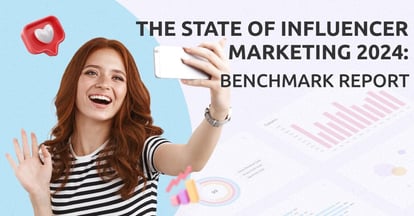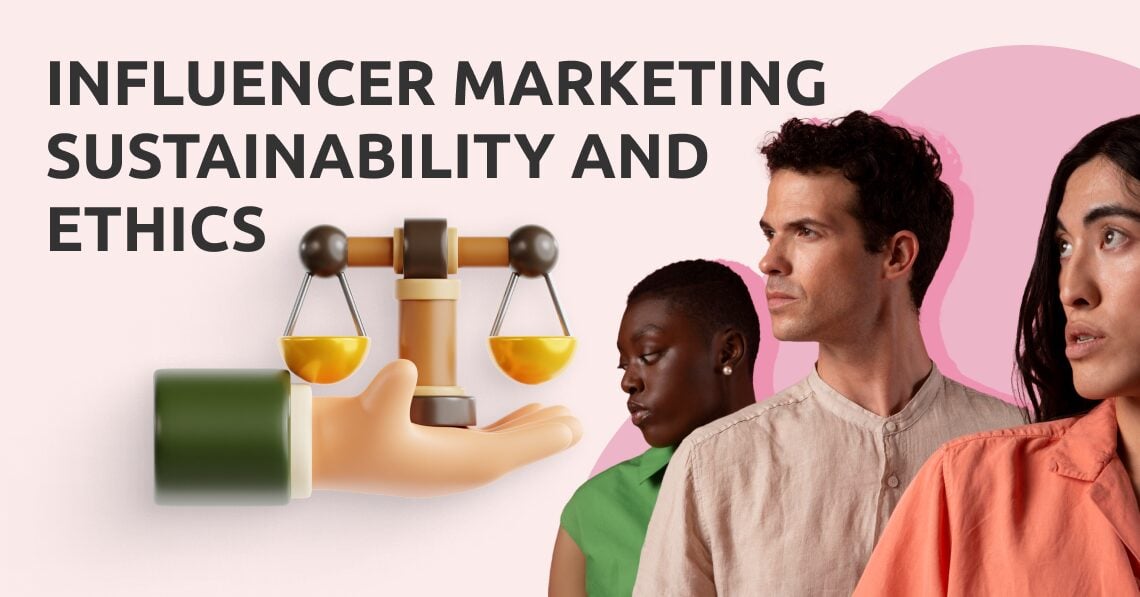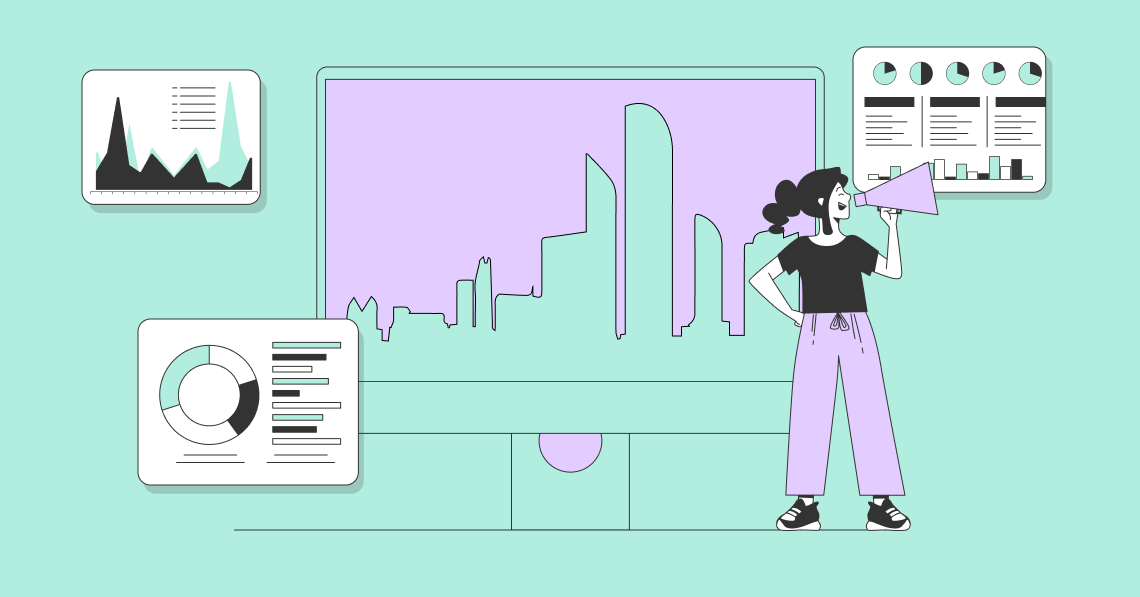The Influencer Marketing Benchmark Report 2024 is our latest overview of the influencer marketing industry. It summarizes the thoughts of more than 3000 marketing agencies, brands, and other relevant professionals regarding the current state of influencer marketing, along with some predictions of how people expect it to move over the next year and into the future.
The world around us has changed considerably over the last few years. The arrival of Covid in 2020 turned much of the world on its head, with enforced lockdowns and scenes reminiscent of a Hollywood disaster movie. By 2024, however, much of the world has learned to live with Covid but struggled to cope with its financial fallout. We still suffer from supply chain disruptions, a chronic shortage of key workers, and creeping inflation threatening to unsettle the global economy. And that doesn’t even include the effects of Global Warming, associated climatic effects, and wars raging on multiple fronts.
Unsurprisingly, many businesses have struggled to survive in this new environment. And those that have made it this far need to find new ways to market, so they stand out in the minds of consumers. Creator and influencer marketing appear to be more important than ever for connecting brands with their target customers.
We’ve also seen major advances in artificial intelligence (AI) and machine learning (ML) in recent years. ChatGPT and other generative AI products have made a significant impact in many ways (not just “Deep Fakes” of Hollywood celebrities) and are now prevalent in many products we use daily. Google is experimenting with making AI an integral part of its search engine. Brands involved in influencer marketing can use AI in most phases of the process, from assisting influencer discovery to creating reports at the end of campaigns. If anything, however, we were surprised by how little change there has been in AI usage this year by the marketers who participated in our study, compared to results over the last few reports.
As well as our annual survey collating data related to the influencer marketing industry, the Influencer Marketing Benchmark Report 2024 also incorporates data from HypeAuditor, and our Diversity, Equity & Inclusion (DEI) in Influencer Marketing: Racial and Gender Inequalities Report.
The State of Influencer Marketing Benchmark Report 2024:
- Notable Highlights
- Survey Methodology
- Influencer Marketing Expected to be Worth $24 Billion by the End of 2024
- Sizeable Increase in Content in Recent Years, Rate Increasing After Covid Lull
- An Increasing Majority Have a Standalone Budget for Content Marketing
- Nearly 2/3 of Respondents Felt the Impact Of 2023’s Macroeconomic Woes
- The Vast Majority of Respondents Believe Influencer Marketing to be Effective
- More Than 85% of Our Respondents Intend to Dedicate a Budget to Influencer Marketing in 2024
- Nearly 60% of Respondents Intend to Increase Their Influencer Marketing Spend in 2024
- 24.2% of Respondents Intend to Spend More Than 40% of Their Marketing Budget on Influencer Marketing
- Although Most Brands Spend Less Than $50K on Influencer Marketing, Nearly 15% Spend Over $500K.
- Firms Value Working with Influencers They Know
- More Than 60% Plan to Use AI or ML in Their Influencer Campaigns
- The Main Purpose of AI/ML Is for Influencer Identification
- TikTok Still Expected to Deliver the Best ROI for Short-Form Video
- Strong Preference for Smaller Influencers
- More Brands Now Pay Influencers Than Give Them Free Product Samples
- Major Change in Payment System This Year: Half of the Payments to Influencers are Made as a Percentage of Sale
- Wire Transfer is Marginally the Most Popular Way to Pay influencers, However, Other Methods Are Almost as Common
- Nearly 80% of Brands Track Sales from Influencer Campaigns
- Email Addresses and Referral Links are the Most Popular Ways to Attract Sales
- 80%+ Recognize the High Quality of Customers from Influencer Marketing Campaigns
- More Than 60% of Respondents Have Used Virtual Influencers
- 70% Measure the ROI on Their Influencer Marketing
- The Most Common Measure of Influencer Marketing Success is Views / Reach / Impressions
- Most Consider Earned Media Value a Good Measure of ROI
- 83% of Firms Take Their Influencer Marketing Spending from Their Marketing Budget
- 76% of Influencer Marketing Campaigns are Run In-House
- 72% of Respondents Use Tools Developed In-House to Execute Influencer Marketing Campaigns
- Nearly 60% of All Respondents Use 3rd-Party Platforms
- The Most Popular Use of Influencer Platforms is for Influencer Discovery and Communication
- TikTok Continues to be the Most Common Channel Used by Most Brands Engaging in Influencer Marketing
- User Generated Content (UGC) is the Main Objective When Running an Influencer Campaign
- Influencer Fraud is Still of Concern to Respondents
- Increase in Respondents Who Have Experienced Influencer Fraud
- Brands are Finding it “Relatively” Easy to Find Appropriate Influencers
- The Majority of Firms Have Little Concerns About Brand Safety in Influencer Campaigns
- Nearly 75% Believe Influencer Marketing Can be Automated
- Content Production is Now Considered Most Valuable When Partnering with Influencers, But Audience Relationship is Still Valued
- More Than 60% of Respondents Prefer Their Influencer Marketing to be Campaign-Based
- The Vast Majority Consider Influencer Marketing to be a Scalable Tactic in their Marketing Ecosystem
- Views/Reach/Impressions Are Now the Most Important Criteria When Evaluating Influencers
- 60%+ of Brands Work with More Than 10 Influencers
- Nearly Half of All Influencer Campaigns Are Run Monthly
- Finding Influencers to Participate is Again the Greatest Challenge for Those Who Run Campaigns In-house
- Social Media User Demographics Statistics
- The Majority of Instagram Users Are Aged 25-34
- TikTok is the Favorite of 13–24-Year-Olds.
- 57% of YouTube Viewers Are Male, But Females Dominate the Younger Age Groups
- Lifestyle and Music Top Instagram Influencer Niches
- Influencer Engagement
- Instagram Influencer Fraud Has Continued to Decline Since 2019
- The Most-Mentioned Brands on Social Media in 2022
- Target Was the Most Mentioned Brand on TikTok in 2022
- Diversity, Equity, and Inclusion (DEI) in Influencer Marketing:
- Nearly 60% of Influencers Felt They Faced Discrimination
- Almost 50% of Influencers Face Discrimination Based on Their Gender
- TikTok Provided the Worst Discrimination Faced by Influencers
- Macro- and Mega-Influencers Suffer Most from Discrimination
Notable Highlights
- The Influencer Marketing Industry is set to grow to approximately $24 Billion by the end of 2024
- 63% plan to use AI in executing their influencer campaigns, 55% of these brands will use AI for influencer identification
- 85% of our survey respondents believe influencer marketing to be an effective form of marketing, an increase from previous years
- 75% admit to having increased the amount of content they produce and share
- 60% of those respondents who budget for influencer marketing intend to increase their influencer marketing budget over 2024
- Nearly 1/4 of respondents intend to spend more than 40% of their entire marketing budget on influencer campaigns
- There is a strong preference for working with small (nano - 44% and micro - 26%) influencers ahead of expensive macro-influencers (17%) and celebrities (13%)
- It is now the norm to pay influencers (41%), rather than just give them a free product (31%).
- TikTok (utilized by 69% of brands using influencer marketing) is by far the most popular influencer marketing channel, now well ahead of Instagram (47%), YouTube (33%) and Facebook (28%)
- The main purpose of running influencer campaigns is to create User Generated Content (56%). Generating sales (23%) is a distant second.
Survey Methodology
We surveyed approximately 3000 people from a range of backgrounds. 41.9% of our respondents work at marketing agencies (including those specializing in influencer marketing), and 22.3% consider themselves brands (or brand representatives). 5% are PR agencies. We merged the remaining 30.8% as Other, representing a wide range of occupations and sectors.
In the 2022 and 2023 reports, we saw a relative increase in B2B businesses over B2C firms compared to 2021. However, this year we had a noticeable increase in B2C respondents. 73.1% of those surveyed identify as part of the B2C sector (up from 62%), with the remaining 26.9% (down from 38%) running B2B campaigns.
The most popular vertical represented remains Fashion & Beauty (21.6% of respondents, down from last year's 25%). Gaming became the second-most popular sector (11.9%), followed by Sports (8.6%). Also at 8.6%, Travel and Lifestyle was only two-thirds as popular a category for respondents this year than last. Family, Parenting & Home (7.6%) also decreased representation in 2024. After a big drop last year, Health and Fitness rebounded slightly to a 7.6% share. However, the notable change this year was the expansion of the category we’ve called Other to cover 34.1% of the respondents (more than any individual category). This covers every other vertical imaginable and signifies the variety of respondents we had for our survey.
We have once again noticed a widespread global response to this year’s survey. 19.5% of respondents came from Asia (APAC) (14% in 2023) and another 19.5% came from the USA (16% in 2023). 14% of our respondents come from Africa (31% in 2023), 10% in South America (4% in 2023), and 8.6% from Europe (8% in 2023). 28.5% describe their location as Other (28% 2023). It is highly likely that most respondents who selected Other come from Canada, Mexico, or other parts of North America.
The bulk of our respondents came from relatively small organizations, with 35.6% representing companies with fewer than ten employees. 21.5% had 10-50 employees, 12.3% 50-100, 14.2% 100-1,000, and 16.4% came from large enterprises with more than 1,000 employees. Overall, this spread is very similar to last year’s sample.
We’ve noticed an increase in the percentage of our respondents who operate eCommerce stores compared to those who don't. For example, 57.6% of the respondents run eCommerce stores versus 42.4% not doing so. This represents a noticeable increase in the percentage of influencer-contracting brands operating eCommerce stores. Last year, 51% of such brands ran eCommerce stores.
This is surprisingly high. Remember that our survey respondents come from various backgrounds – brands, marketing agencies, PR agencies, and "Other." Clearly, eCommerce is increasing in popularity for all types of businesses. Website management systems with eCommerce capabilities, such as Shopify, now make it easy for even small businesses to set up an online store. Consumers now expect to do much of their everyday shopping online, and even many traditional brick-and-mortar stores now make this easy.
However, one thing to be aware of is that the Influencer Marketing Hub now caters to all types of online marketing. A more significant portion of the site is now devoted to articles about eCommerce than in previous years. As a result, we may have a higher percentage of eCommerce marketers (compared to influencer marketers) visiting the site and answering our survey than previously.
Influencer Marketing Expected to be Worth $24 Billion by the End of 2024
Despite concerns that influencer marketing (indeed, all marketing) might decrease due to COVID-19, it didn’t and has continued to increase in popularity since 2020. Initially, some industries, such as tourism and airlines, had to cut back their operations and marketing, but many others adjusted their models to survive in the post-Covid world. Now there is renewed life in these more Covid-affected industries too.
Over the last couple of years, we have experienced a global economic downturn, and increasing inflation rates, making it more difficult for people to pay for their everyday purchases, never mind perceived extras. Firms must compete more fiercely for the consumer’s dollar, pound, or euro. Successful businesses understand the importance of marketing, including influencer marketing, in tough times, and increase their expenditures on this, even when they have to cost-cut expenses elsewhere.
From a mere $1.7 billion at the time of this site's beginning in 2016, influencer marketing grew to have an estimated market size of $16.4 billion in 2022. It was then predicted to jump a further 29% to an estimated $21.1 billion in 2023. Despite these already impressive growth figures, the sector is expected to see even more robust expansion, with Influencer Marketing's Hub predicting the market size to reach an estimated $24 billion by the end of 2024, indicating strong ongoing growth momentum in influencer marketing despite challenging economic conditions.
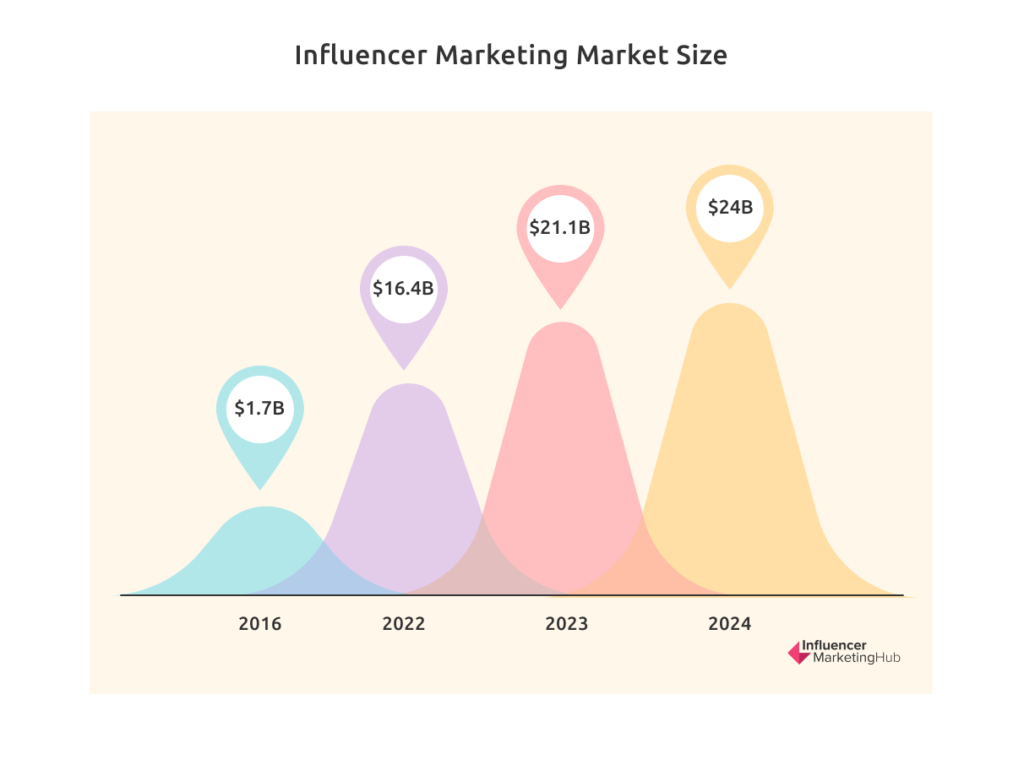
Results From Our Survey
Sizeable Increase in Content in Recent Years, Rate Increasing After Covid Lull
We asked our respondents whether they had increased content output over the last two years. A sizable 78.5% of them admit to having upped the amount of content they produce. This is up on last year's 71%.
After a small fall in increased content last year, most firms realize the insatiable demand for online content. The majority of marketers have increased their content marketing, year after year. Much of this increase in content must be created and delivered by influencers on behalf of brands.
The types of content shared have changed over time, however. Our most recent Social Media Marketing Benchmark Report found that the most common types of posts on Facebook are now link posts (49.2%), followed by photo posts (30.8%), video posts (17.7%), and in a distant last, status posts (2.3%). On Instagram (business accounts) photo posts (41.7%) are the most popular, followed by video posts (38.2%), and carousel posts (20.0%). Alongside these platforms, the popularity of YouTube has led to a demand for more video posts, and the success of TikTok (and its rivals like Threads) has seen a notable shift towards short video content.
An Increasing Majority Have a Standalone Budget for Content Marketing
Nearly 2/3 (65.8%) admit to having a standalone budget for content marketing. This figure creeps up each year and is up from 63% last year, 61% in 2022, 59% in 2021, and 55% in our 2020 survey.
These figures compare with a surprising finding from HubSpot that just 29% of their marketer respondents actively use content marketing, but 50% of marketers plan on increasing their investment in content marketing in 2024.
Nearly 2/3 of Respondents Felt the Impact Of 2023’s Macroeconomic Woes
The world economy is currently in its most challenging situation since the arrival of influencer marketing. So, it was interesting to see whether the Marketing Departments at our respondent businesses are feeling the pinch. Indeed, 64.7% of our respondent businesses say they felt the impact of macroeconomic circumstances during 2023.
The Vast Majority of Respondents Believe Influencer Marketing to be Effective
Unsurprisingly, considering the overall positive sentiment expressed about influencer marketing, just over 84.8% of our survey respondents believe influencer marketing is an effective form of marketing, up from 83% last year.
This statistic has exceeded 80% in each of our surveys since 2017, however, it is still lower than 2022’s 90% support. It is clear that most firms that try influencer marketing are happy with the results and are willing to continue with the practice. However, most influencer marketing partnerships work and result in a win-win situation for all parties.
More Than 85% of Our Respondents Intend to Dedicate a Budget to Influencer Marketing in 2024
The general satisfaction felt by firms that have engaged in influencer marketing seems to flow through to their future planning. For example, 85.8% of our respondents indicated that they would be dedicating a budget to influencer marketing in 2024.
This is a moderate increase from last year's 82% result and considerably up from the 37% who claimed they would dedicate a budget in our first survey in 2017. This continuing increase could result from firms increasing marketing to combat the effects of the current global financial crisis and other negative consumer sentiment.
Nearly 60% of Respondents Intend to Increase Their Influencer Marketing Spend in 2024
59.4% of those respondents who budget for influencer marketing intend to increase their influencer marketing budget over the next 12 months. An additional 22.1% indicate that they expect to keep their budgets the same as in 2023. A further 9.3% stated that they were unsure how their influencer marketing budgets would change. This leaves just 9.3% intending to decrease their influencer marketing budgets.
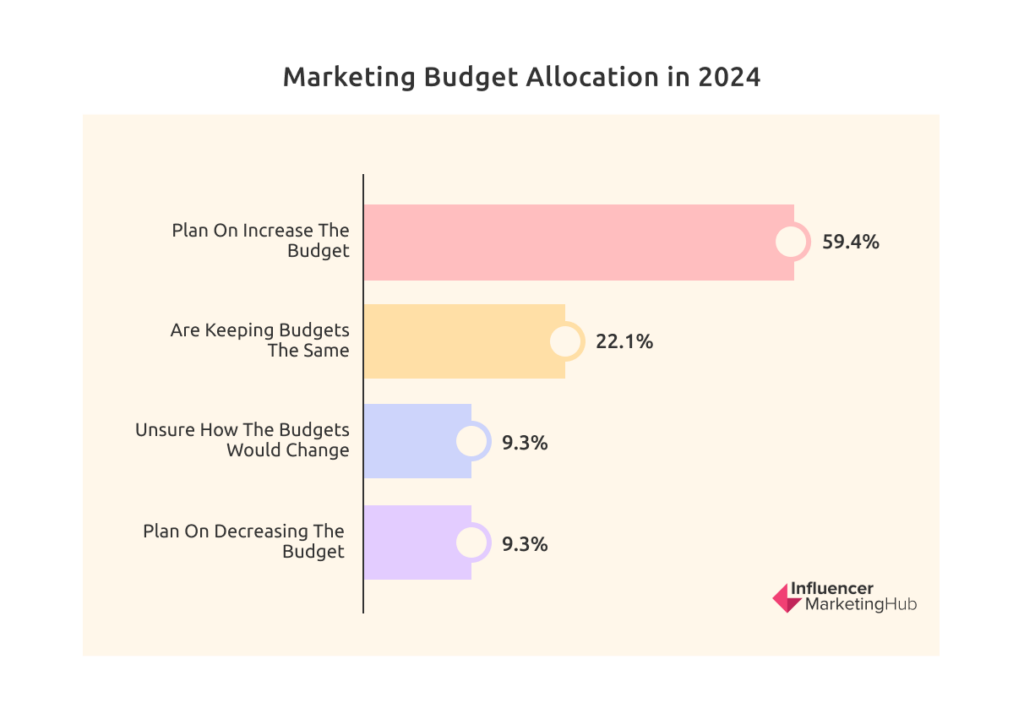
These results suggest a sizable spending on influencer marketing in 2024, although at a slower rate than last year. The 9.3% planning to decrease their influencer marketing budget is slightly higher than last year’s 7% figure.
Although this is still proof that influencer marketing continues to be successful and is now sufficiently mainstream that it can’t be considered just a fad, it may indicate that budgets are stretched in these tough economic times, with some needing to find savings. Brands and marketers still recognize the effectiveness of influencer marketing, however, and don’t appear to be searching for something new. Further evidence of this can be seen in the next statistic.
24.2% of Respondents Intend to Spend More Than 40% of Their Marketing Budget on Influencer Marketing
Influencer marketing is, of course, merely one part of the marketing mix. Most businesses balance their marketing budget across a wide range of media to reach the greatest possible relevant audience. However, as we saw above, nearly 86% of our respondents' firms intend to include some influencer marketing in their mix.
We notice a continuing trend in firms devoting a sizable percentage of their marketing budget to influencer marketing. Clearly, quite a few brands have found success with their influencer marketing and decided to return for more.
24.2% of respondents are dedicated fans of influencer marketing, intending to spend more than 40% of their marketing budget on influencer campaigns. This is comparable with 2023’s 23%, but much increased upon 2022’s 5%, 2021's 11%, and 2020's 9%.
11.5% of respondents (down from 13% in 2023) intend to devote 30-40% of their marketing budget to influencer marketing. An additional 15.8% plan to allocate 20-30% of their total marketing spending to influencer marketing.
22.4% of respondents expect to spend 10-20% of their marketing budget on influencer marketing this year. 26.1% expect to spend less than 10%, which is higher than last year’s 20%.
Although Most Brands Spend Less Than $50K on Influencer Marketing, Nearly 15% Spend Over $500K.
Brands of all sizes participate in influencer marketing. Therefore, it should be no surprise to see quite some variation in what firms spend on the activity. 47.4% of the brands surveyed said they spend less than $10K annually on influencer marketing (higher than last year's 43% - these are probably a mix of newcomers dabbling with influencer marketing combined with more seasoned marketers operating with reduced budgets). 20.9% spent between $10K and $50K (down from last year’s 22%). A further 8.9% spent $50K to $100K (noticeably lower than 2023’s 14%), 8.3% $100K to $500K (down from 10%), with a sizable 14.5% spending more than $500K (up from last year’s 11% nearly 4x more than in 2022).
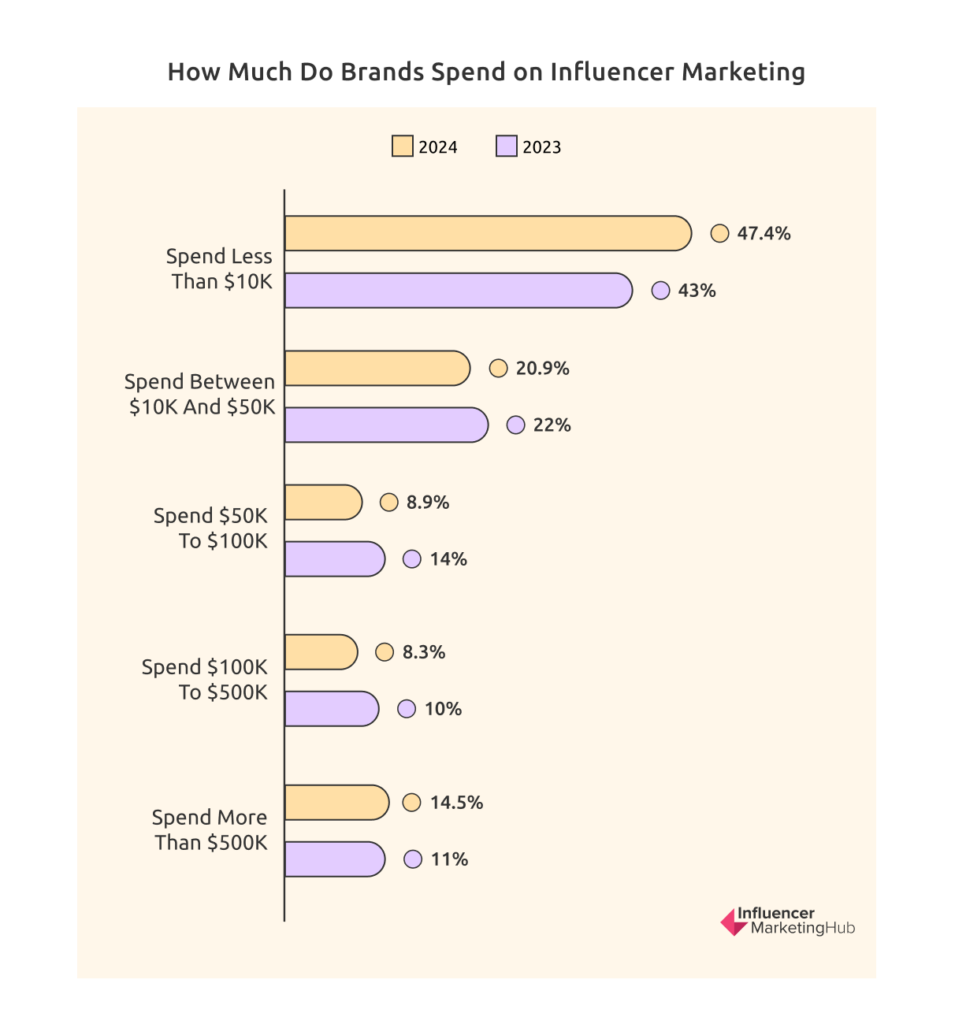
Clearly, the amount that a firm spends depends on its total marketing budget affects the proportion it chooses to devote to influencer marketing. Those brands that opt to work with mega-influencers and celebrities spend more than brands that work alongside micro- or nano-influencers. In 2022 we saw a leveling out of influencer marketing spending, with most brands spending a middling proportion of their marketing budget on influencer marketing. Last year, however, brands moved their spending sums to the extremes. Brands with happy influencer marketing experiences increased the percentage of their marketing budget they spent on the activity. However, brands that experienced less happy outcomes decreased or eliminated spending on the activity, turning their attention to other forms of marketing. This year saw a small movement back towards a more balanced pattern of spending.
Firms Value Working with Influencers They Know
We asked our respondents whether they had worked with the same influencers across different campaigns. The majority, 63.2% (61% last year, 57% in 2022) said they had, versus 36.8% (39% last year, 43% in 2022) who claimed to use other influencers for their campaigns (or perhaps had only had one campaign so far). We can now see a clear pattern of brands preferring to work with influencers they know.
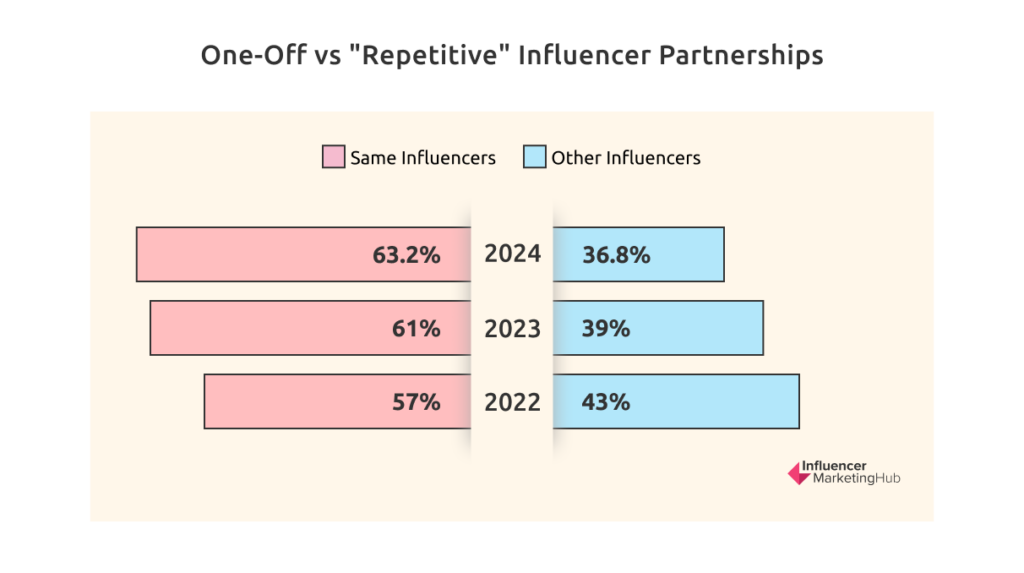
Clearly, brands prefer to build relationships with existing influencers rather than go through the entire influencer selection process every time they run a campaign. Of course, some firms will have a range of influencers they call upon depending on the nature of a particular campaign, the products they are trying to promote, and the target market. The 2% increase in firms working with existing influencers probably indicates the natural increase in influencer-business relationships over time. The more successful an influencer campaign is, the greater the likelihood that the parties will want to work together on other campaigns.
More Than 60% Plan to Use AI or ML in Their Influencer Campaigns
Technology is coming to influencer marketing. Artificial Intelligence (AI) and Machine Learning (ML) have been headlining the news often over the last year. We asked our respondents whether they planned to utilize AI and ML over the next year to identify influencers or create effective campaigns. A very sizable 63% said they would, alongside 27.1% who thought they might. Only 9.9% gave an unequivocal no to this question. Clearly, AI and ML have hit the mainstream.
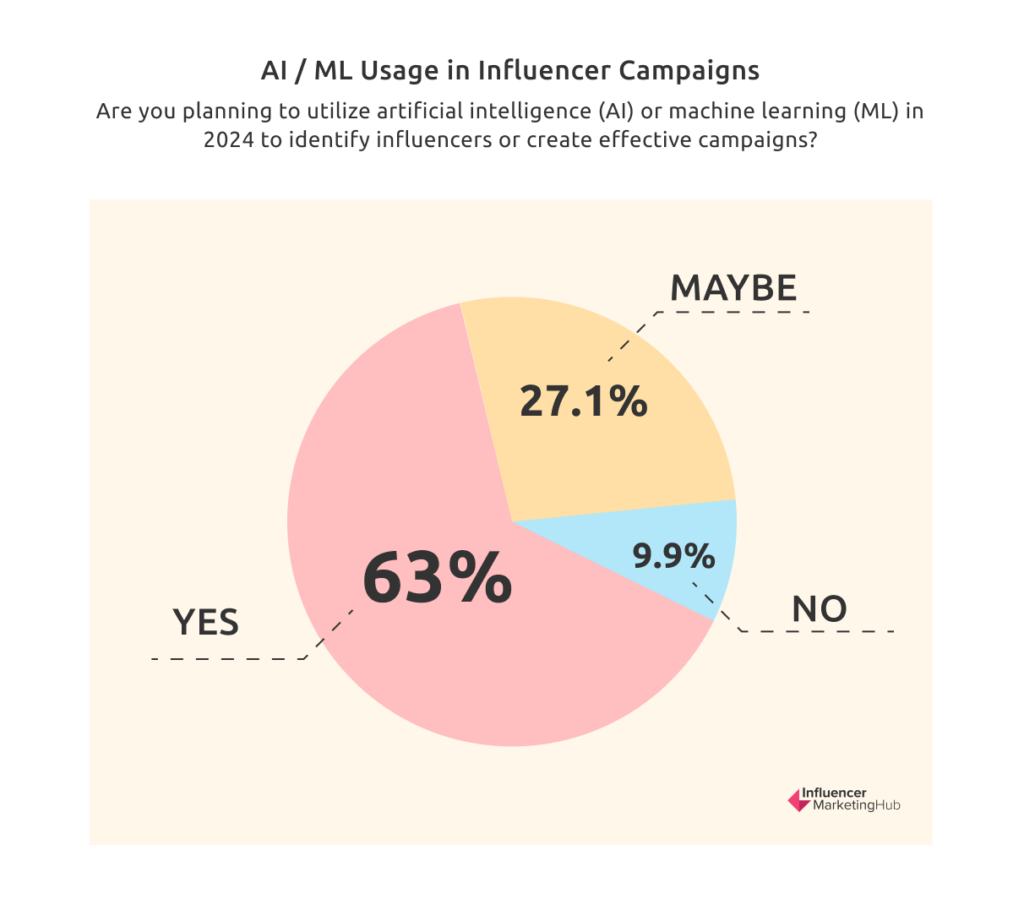
The Main Purpose of AI/ML Is for Influencer Identification
We asked those who said they would (or might) use AI/ML in their influencer marketing how they intended to use it. The most popular suggestion (55.8%) was using social media data analytics to identify the most effective influencers for a particular brand or campaign. Although the respondents didn’t clarify this, they presumably intend to work with one of the many influencer platforms offering influencer identification technology.
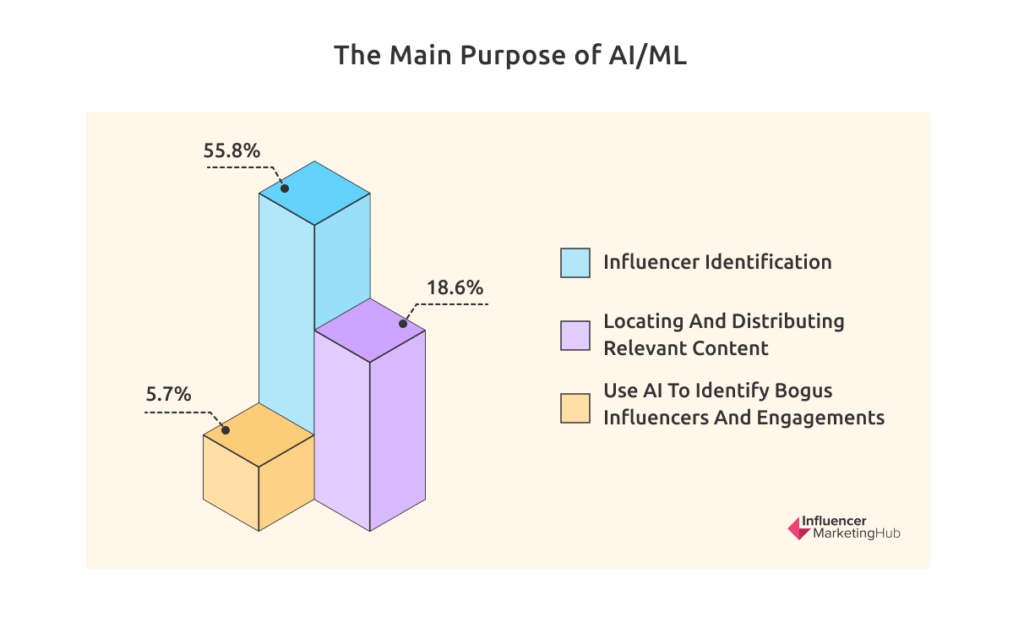
Although somewhat less common, the second most popular intended use of AI in influencer marketing is locating and distributing relevant content (18.6%). The popularity of this has noticeably increased from last year’s 13.3%.
Interestingly, 5.7% of our respondents intend to use AI to identify bogus influencers and engagements, an almost identical percentage as in last year’s results. It will be interesting to see if this figure rises over time, as more people discover what AI can achieve.
TikTok Still Expected to Deliver the Best ROI for Short-Form Video
Until recently, the name TikTok was synonymous with short-term video, although ardent Snapchat fans may dispute this assessment. However, existing social media companies, YouTube and Meta (Facebook/Instagram) have been hit by the popularity of comparative newcomer, TikTok. Just as Instagram introduced Stories to try and neuter Snapchat, these older social channels have now introduced TikTok-killer features. You will undoubtedly notice YouTube Shorts, Instagram Reels, and even Facebook Reels in your feeds.
For the second year running, we asked our respondents about which they believed would deliver the best ROI (although we didn’t show Facebook Reels separately in our survey options). Last year we saw a surprisingly close battle for the top position between TikTok (42%) and Instagram Reels (34%).
This year, however, TikTok has reasserted itself at the top, with 50.1% support, ahead of 29.9% for Instagram Reels. A much reduced 12% believed YouTube Shorts would deliver the best ROI, alongside the usual diehard Snapchat disciples, with 8% opting for Snapchat Spotlights (who would undoubtedly point out that support for their platform has increased 33% from last year’s 6% figure). We won’t mention the words “margin of error” too loudly.
Strong Preference for Smaller Influencers
We asked those of our respondents intending to work with influencers this year the size of influencer (in terms of followers) they were most likely to utilize. If they used more than one type, they had to pick their preferred option.
44% of brands chose nano-influencers (1K-10K followers) as their most likely partners (up from 39%), followed by 25.7% opting for micro-influencers (10K-100K) (down from 30%).
Far fewer brands choose to place their focus on larger influencers, with 17.4% opting for macro-influencers (100K-1M) (down from 19%), and 12.9% mega / celebrity influencers (up slightly from 12%).
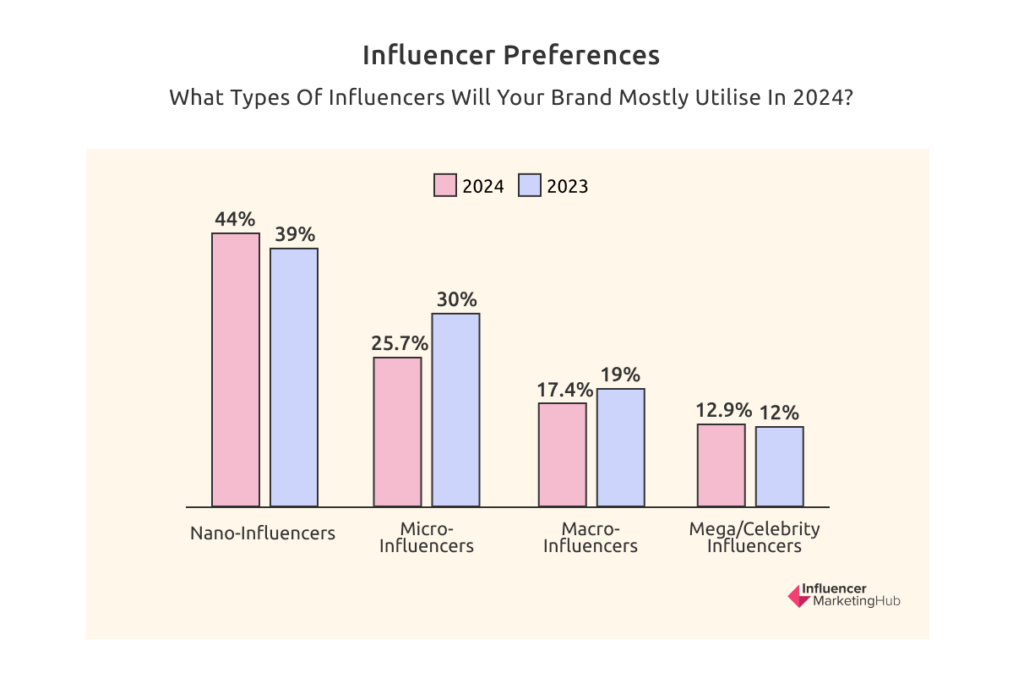
This possibly reflects the reality of a small to medium-sized business. You simply can’t afford the fees charged by macro and mega-influencers. In addition, there are far fewer of these more popular influencers, limiting the number of brands they can work with. However, it may also reflect that nano and micro-influencers have far higher engagement rates than their more famous counterparts and may be better value for money for brands wanting to reach a specific dedicated audience.
More Brands Now Pay Influencers Than Give Them Free Product Samples
There has been a notable change in the answers to this question over time. Previously, those giving free samples outnumbered those paying cash to influencers. In 2022, numbers were approximately equal. However, last year, noticeably more respondents stated that they pay money to influencers, than give them free products. This trend has continued with 40.8% offering monetary rewards, 30.8% giving free product samples, 18.9% giving their influencers a discount on their product or services (presumably more expensive items), and a smaller 9.4% entering their influencers in a giveaway.
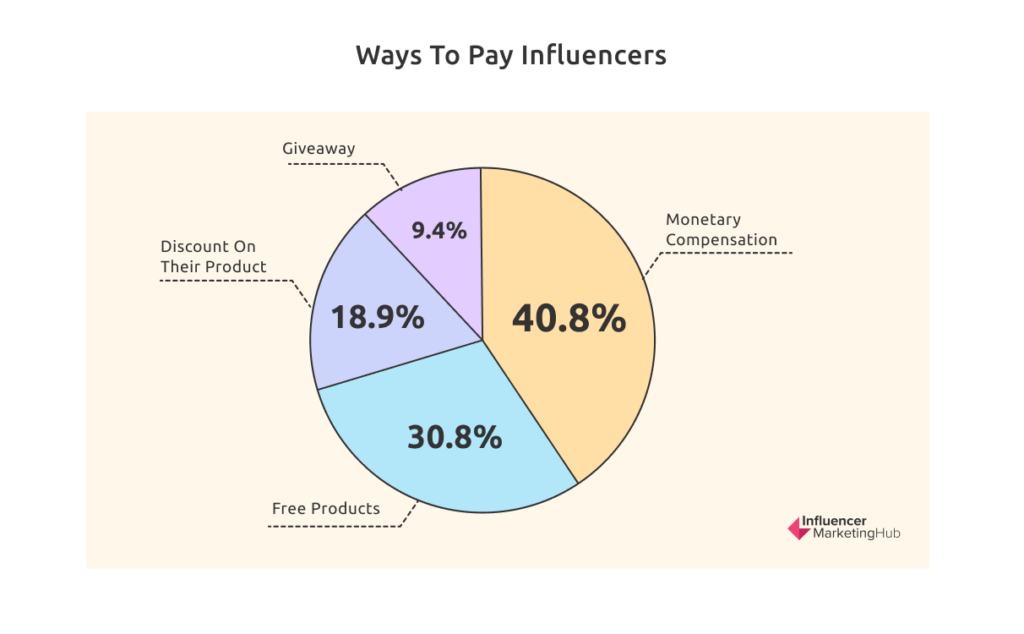
While more brands are willing to pay influencers for their marketing services, 40.8% is still a relatively low percentage, much less than half. It is probably a sign of just how many firms work with micro and nano-influencers. These relative newcomers are happy to receive payment in kind rather than cash. Presumably, it is mainly larger firms with more sizable marketing budgets that pay influencers with money. However, this is gradually changing as even nano and micro-influencers begin to understand their worth as advocates for a brand.
Major Change in Payment System This Year: Half of the Payments to Influencers are Made as a Percentage of Sale
As we prepare the State of Influencer Marketing Benchmark Report annually, we don’t generally tend to see major changes in survey results each year. In most cases, movement is evolutionary rather than revolutionary. However, this question saw a significant change in 2023 that has continued this year.
Back in 2022, the most common method (49.6%) was to pay at a flat rate. However, a sizable percentage of other brands (42%) structured their influencer marketing payments more like affiliate marketing payments by paying a percentage of any sales made as a result of the influencer marketing. Payments based on product level (4%) and tiered incentives (4%) were less common.
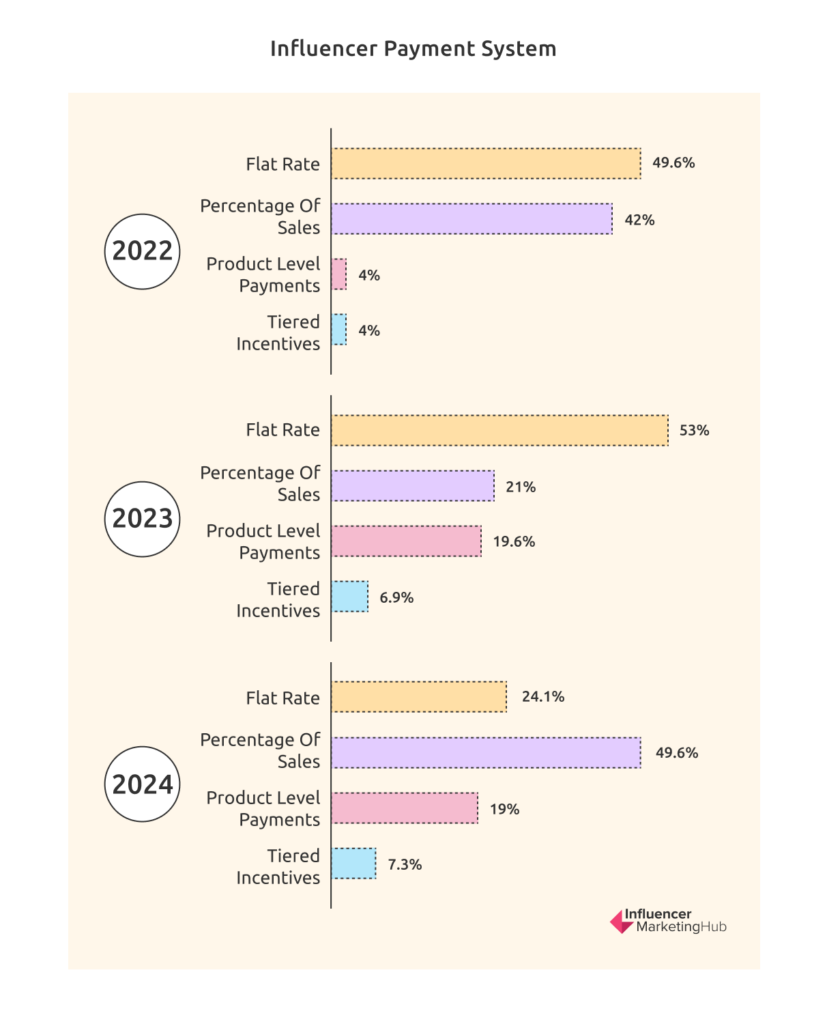
For the last two years, however, things have changed considerably. The most common method (49.6%) now is paying as a percentage of sales value. Flat rate payments now just represent 24.1% of sales, with sales based on product level (19%) now five times as popular as in 2022. Those paying by tiered incentives remain low at 7.3%.
It’s hard to understand the reason for such a significant change. Perhaps in these tough economic times brands require a higher level of evidence for the effectiveness of their influencer marketing spending. Possibly more brands engaging in influencer marketing have made increased sales the goal of their campaign, and fewer targeting brand awareness. It will be most interesting to see if this becomes a permanent change.
Wire Transfer is Marginally the Most Popular Way to Pay influencers, However, Other Methods Are Almost as Common
Isolating those respondents who pay money to influencers, we asked them their preferred payment method. 29.2% chose wire transfer (up from 28% last year), 27.2% paid by PayPal (29% last year), 25.1% said they paid manually (25% last year), and 18.5% a third-party payment service, e.g., Wise (17% last year). Manual payments include payments made by cash on delivery (COD), money orders, bank transfers, and even email money transfers in some locations like Canada. If we look over a longer period, however, there is a clearer shift from PayPal to wire transfer. Between 2022 and 2024 PayPal has fallen proportionately from 34% to 29% to 27.2%. Over the same period wire transfer has increased in popularity from 15% to 28% to 29.2%.
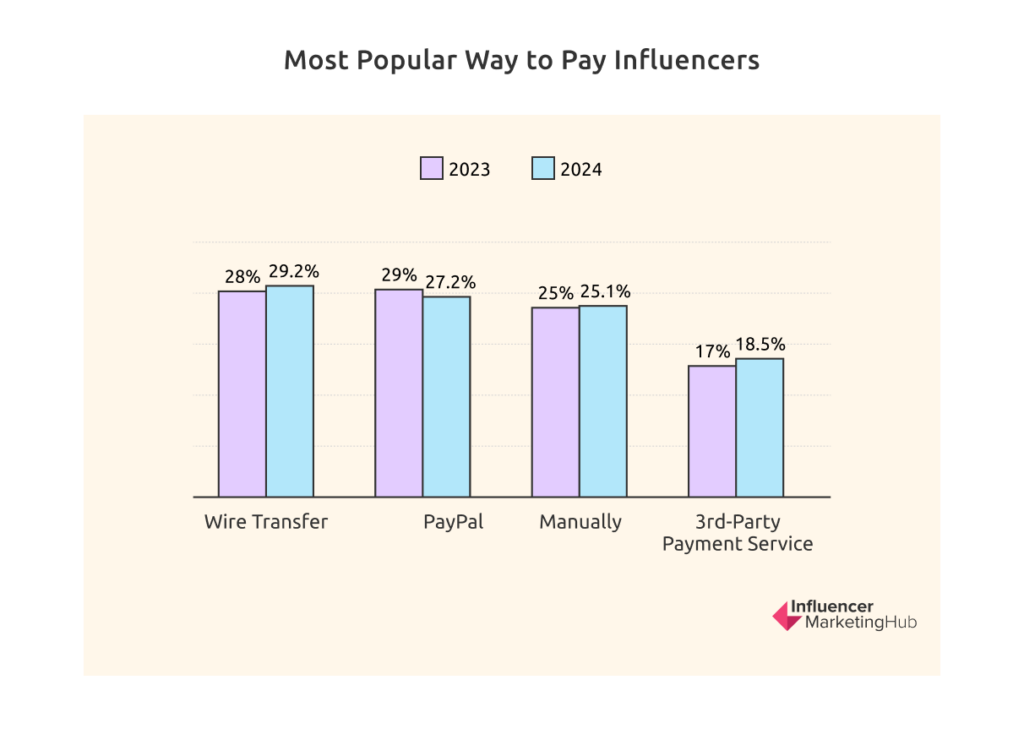
Payment methods depend very much on the location of the influencers. If they are based in a different country from where you operate, PayPal or something like Wise is much easier than a wire transfer or a manual transaction.
Nearly 80% of Brands Track Sales from Influencer Campaigns
Although there are many potential goals for an influencer marketing campaign, it is clear that the majority of firms now undertake influencer marketing to drive sales. Indeed 79.8% of our survey respondents stated that they track sales from their influencer campaigns.
This is up noticeably from last year’s 74% and ties in with the previous statistic indicating that the most popular basis for influencer payment is now tied to the increased sales an influencer’s activity generates. As influencer marketing has evolved new ways to measure success have developed, with specialist platforms assisting brands alongside a recent revamp of Google Analytics.
Email Addresses and Referral Links are the Most Popular Ways to Attract Sales
Those who tracked sales from their influencer campaigns were asked about their methods of determining these influencer-generated sales. People could select multiple options if they used more than one.
The most common method was to use email addresses (29.9%), closely followed by referral links (28.4%). Other methods used included coupon codes (14.7%) and product SKUs (4.2%). There is a notable group of respondents who select “Other” (21%). These figures are similar to last year’s results.
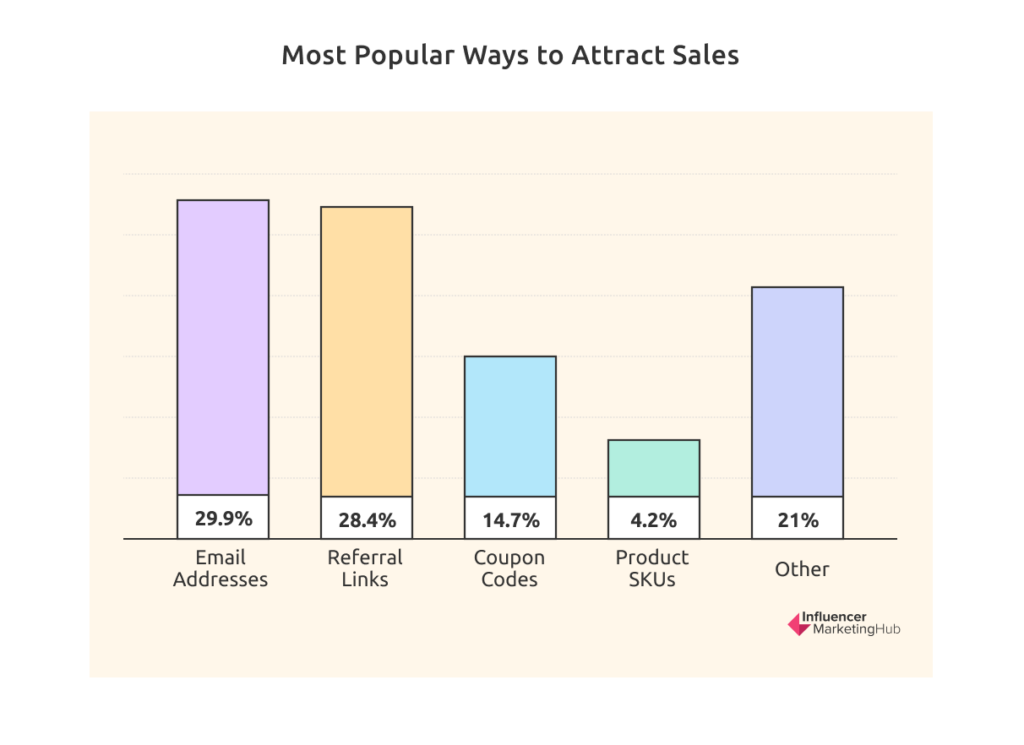
80%+ Recognize the High Quality of Customers from Influencer Marketing Campaigns
Brands carry out influencer marketing for a range of purposes. Some campaigns are designed to increase brand awareness rather than encourage sales. This is because some customers are more lucrative for a business than others – they buy high-margin products and add-ons. In some cases, influencer marketing may bring new customers to the brand, but the additional spending may be less than the cost of running the campaign.
Our survey respondents are highly optimistic about the value of influencer marketing overall. Most agree that influencer marketing attracts high-quality customers, with 83.8% believing that the quality of customers from influencer marketing campaigns is better than other marketing types.
More Than 60% of Respondents Have Used Virtual Influencers
This was a new question in 2023, and we found the results somewhat surprising. When asked about whether they had ever used virtual influencers, 60.4% admitted to having done so. A year on, we found even more users of virtual influencers: 62.2%.
A virtual influencer is a digital character created using computer graphics software. The character is given a personality and acts on social media platforms as if he/she is an influencer. A study in the US found that 58 percent of respondents followed a virtual influencer. Lu from Magalu became the most famous virtual influencer. Magalu is the biggest retail company in Brazil. Their advertising agency created Lu as a virtual assistant back in 2003 and then built her up as the face of the brand. Over time they created social accounts for her and eventually, she became a powerful influencer. She became a cultural celebrity, trendsetter, fashion icon, and social media diva. Global brands like Adidas, Samsung, and McDonald’s hired her as an influencer – giving her 31 million followers at peak (outstripping Barbie, Lil Miquela, Minnie, and many “real” influencers). The Lu from Megalu campaign appears to be over now, however, as her former social accounts are now named after the current “owner”, Magazine Luiza.
It should come as no surprise that brands have taken notice of this virtual influencer trend and want to make financial arrangements with (the representatives of) these virtual influencers.
70% Measure the ROI on Their Influencer Marketing
We saw above that nearly 80% of our survey respondents stated that they track sales from their influencer campaigns. Therefore, it should be no surprise that a similar number (70%) also measure the ROI from their influencer campaigns. This is slightly down on 2023’s 71%, but better (or equal) to 2022's 70%, 2021's 67%, and 2020's 65% results.
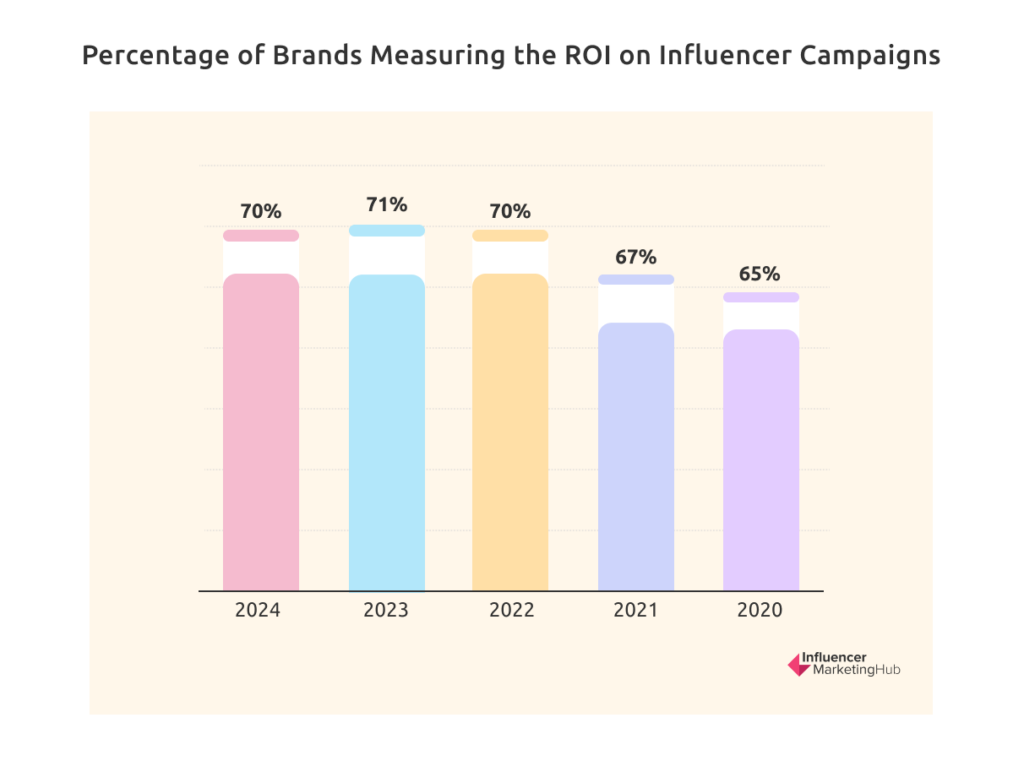
It is somewhat surprising that 30% of firms don't measure their ROI. You would think that every firm would want to know how effective their marketing spending is. At least there is a gradual improvement in this metric, and hopefully, this trend will continue, if not accelerate.
The Most Common Measure of Influencer Marketing Success is Views / Reach / Impressions
This result shows a marked change from previous years, yet it seems inconsistent with increases in firms tracking sales and paying influencers based on the sales they generate.
In 2019 and preceding years, influencer marketing measurement's focus was relatively evenly balanced between differing campaign goals, but Conversion/Sales was the least-supported reason. However, in 2020 things changed, with Conversions/Sales taking a clear, undisputed lead, which continued in 2021 and 2022. In 2023, however, things changed with nearly half of our respondents stating that they measure the success of an influencer marketing campaign by views/reach/impressions.
This trend continued this year. An even higher 54.3% of our respondents stated that they measure the success of an influencer marketing campaign by views/reach/impressions, 23.5% by engagement or clicks, and just 22.1% by conversions/sales.

Most Consider Earned Media Value a Good Measure of ROI
Earned Media Value has become more recognized in recent years as a good measure of influencer campaigns' ROI. We asked our respondents whether they considered it a fair representation. This year, 80.7% favor the measure against 19.3% who don't. This result is similar to last year’s.
Earned Media Value provides a proxy for the returns on the posts that an influencer has historically given the firms they have worked with. It indicates what an equivalent advertising campaign would cost for the same effect. EMV calculates the worth you receive from content shared by an influencer.
The only negative of using this measure is that the calculation of EMV can be complicated. As such, it can sometimes be difficult for marketers to explain the concepts to their managers.
Another name used for earned media value when related to influencer marketing is influencer media value (IMV), which we have written about in What Exactly is an Influencer's Media Value.
Presumably, most of the 19% against using the statistic either don't understand it or struggle to communicate its worth to their management team.
83% of Firms Take Their Influencer Marketing Spending from Their Marketing Budget
This is another statistic that has shown little change over the period we have undertaken this survey (since 2017). 83.2% of the respondents in our survey take their influencer marketing spending from their Marketing Department's budget. The remaining 16.8% take their influencer marketing spending from their PR Department's funds.
Presumably, the firms in the minority group use influencer marketing predominantly for awareness purposes rather than as a direct means to sell their products or services.
76% of Influencer Marketing Campaigns are Run In-House
There has been a small increase in the number of campaigns held in-house this year. 76.2% of our survey respondents (up from 72% last year) claim that they ran their influencer campaigns in-house, with the remaining 23.8% opting to use agencies or managed services for their influencer marketing.
In the past, firms found influencer marketing challenging because they lacked the tools to facilitate the process – organic influencer marketing can be very hit-and-miss, making it frustrating for brands trying to meet their goals. However, many firms now use tools (whether in-house or from third parties) to facilitate the process. For example, they use platforms like Grin, Brandwatch, or Creator.co to discover suitable influencers.
Some brands prefer to use agencies when partnering with micro and nano-influencers because the agencies are more experienced at working with influencers at scale. Also, many larger firms use agencies for all their marketing, including influencer marketing.
72% of Respondents Use Tools Developed In-House to Execute Influencer Marketing Campaigns
In 2022, we introduced a new question asking our respondents whether they used any tools developed in-house to execute their influencer marketing campaigns. The result was that half admitted to using their own tools.
In 2023, we noticed a significant change. 71% of our respondents stated that they used in-house tools for their influencer marketing campaigns, and we saw a similar result this year, with the percentage increasing marginally to 71.8%.
As influencer marketing becomes more mainstream, more businesses have developer talent in-house with the time and capabilities to develop suitable in-house tools.
Nearly 60% of All Respondents Use 3rd-Party Platforms
Just as more firms use in-house tools for influencer marketing compared to previously, noticeably more also use third-party platforms. When asked whether they use third-party platforms to assist them with their influencer marketing, 57.5% said they did (60.3% in 2023).
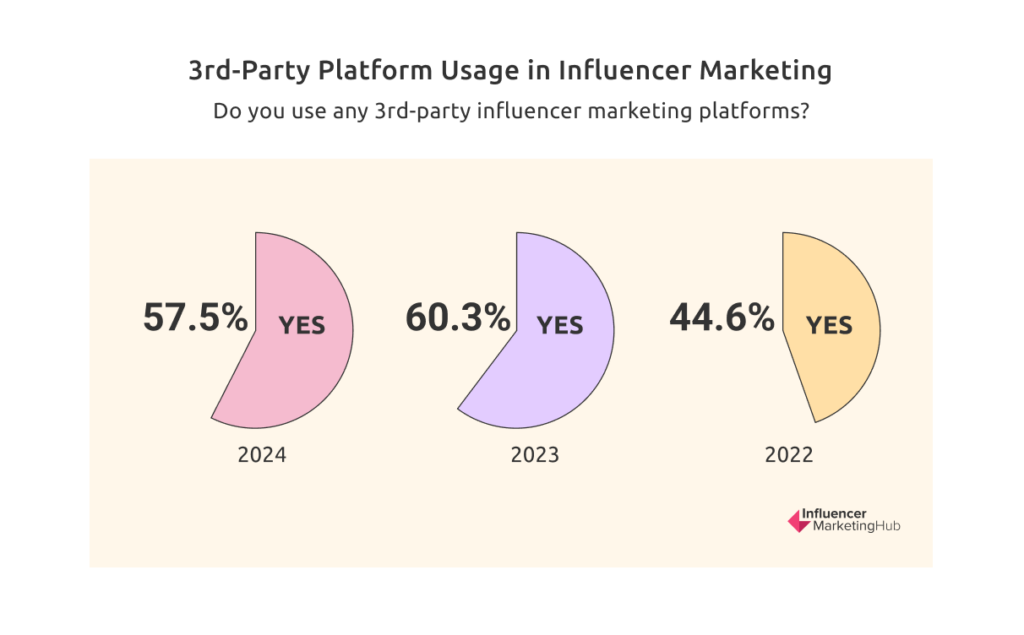
A clear majority of firms now recognize the advantages of using technology to assist them with their influencer marketing.
We must also remember that these figures exclude brands that opt to use someone else's technology (an agency) to carry out much of their influencer marketing for them).
The Most Popular Use of Influencer Platforms is for Influencer Discovery and Communication
The figures in this section show a percentage of those who answered that they use a third-party platform, not the percentage of all survey respondents as a whole.
Influencer platforms initially focused on offering tools to help with influencer discovery. Therefore, it should be no surprise that that is still the most popular use of influencer platforms at 47.9% (although down slightly from last year's 54%).
Other popular uses of the influencer platforms include campaign automation and reporting (35.6%), influencer payments (34.5%), fraud and fake follower analysis (27.8%), paid amplification (24.2%), and conversion attribution (23.2%). An additional 30.9% of respondents use the platforms for some other type of service. The percentage of respondents using the platforms for these purposes has increased in all categories.
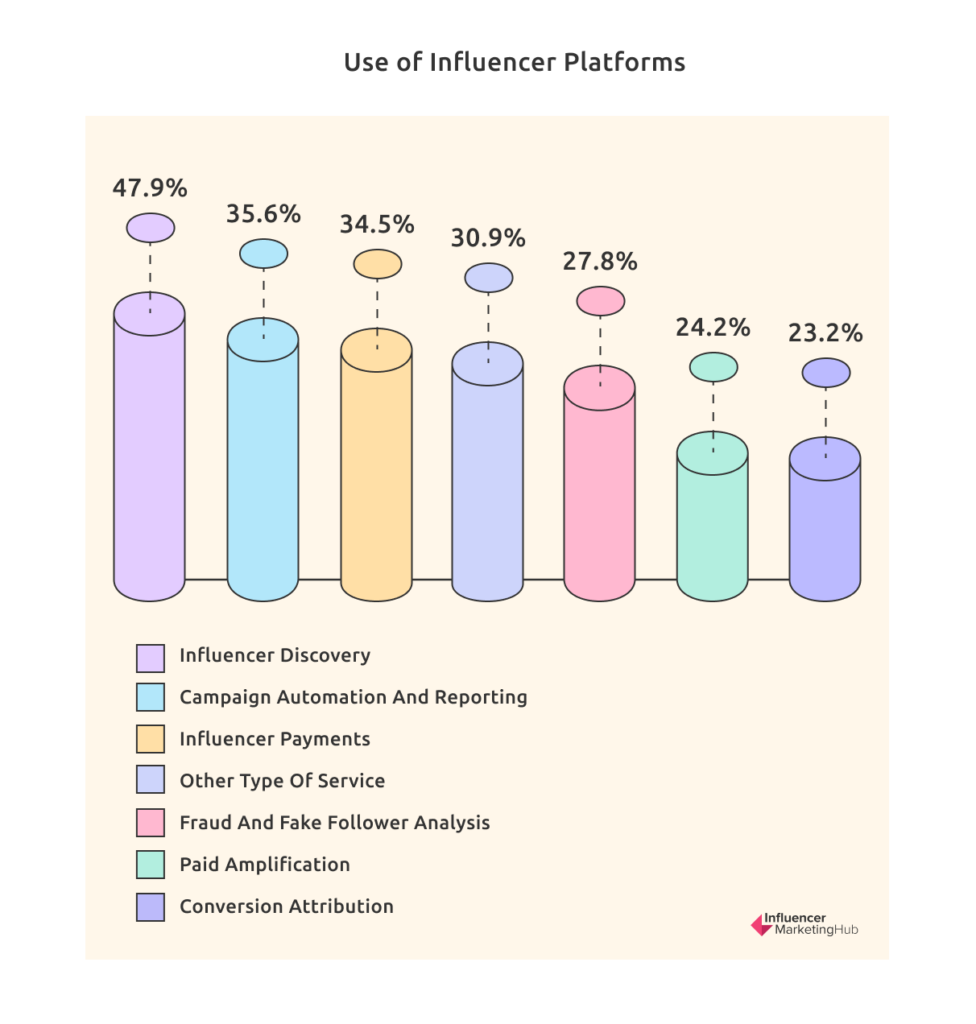
Interestingly many of these percentages are lower than in 2022, but the 26% selecting Other is significantly higher. Clearly, the range of services offered by the platforms has expanded, and many firms now use their newer features.
TikTok Continues to be the Most Common Channel Used by Most Brands Engaging in Influencer Marketing
It wasn’t until 2021 that TikTok made its first appearance in our charts, rising from merely being lumped in "Other" in 2020 to 45% usage in 2021. It kept its popularity in 2022, increasing slightly to 46%, but dropping a position to third. In 2023, however, TikTok came into its own, taking over first place, used by 55.5% of brands tapping into it for influencer marketing campaigns.
However, it has really taken off this year, with even grey-haired marketers understanding the importance of including TikTok in their channel mix and now 68.8% of those respondents who engage in influencer marketing include TikTok in the channels they tap into.
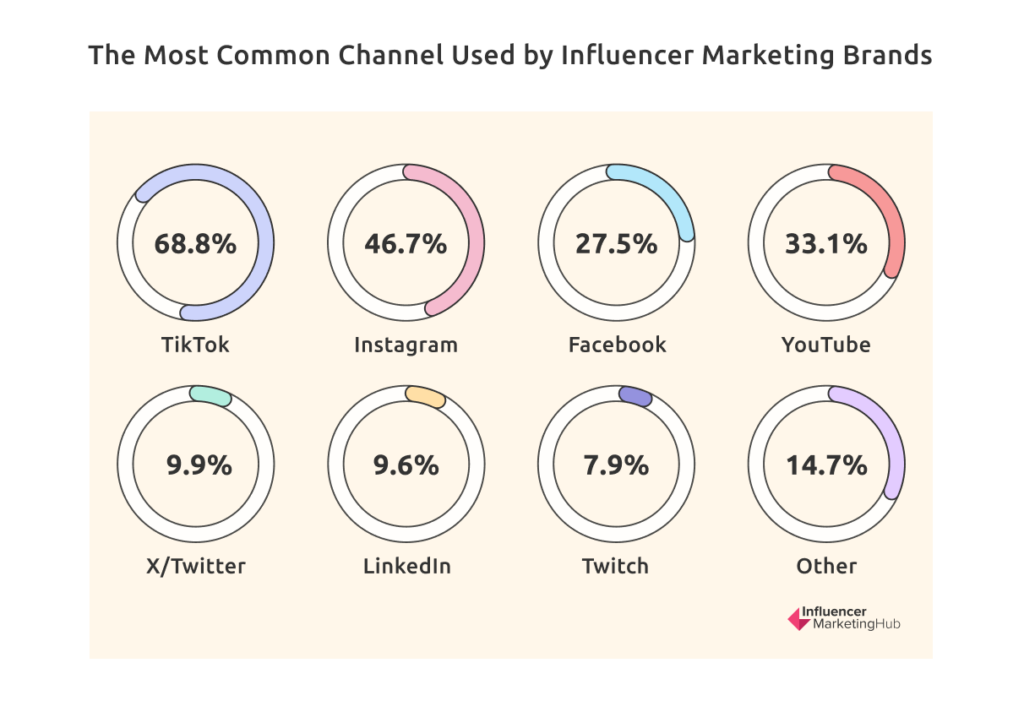
From the inception of the IMH Benchmark Report in 2017 until last year Instagram was the network of choice for influencer marketing campaigns. In 2022 it was used by 79% of our respondents for influencer marketing. It is still popular, but this year “only” 46.7% of brands go to Instagram when they decide to participate in influencer marketing, dropping it down to second place. This is the first time we have found fewer than 50% of respondents to include Instagram in their plans.
It wasn’t all that long ago that Instagram was synonymous with influencer marketing. Is it losing its luster? Time will tell.
Surprisingly, Facebook jumped in popularity as an influencer marketing channel in 2023, with 50% of brands working with Facebook influencers, but it fell back to just 27.5% this year. This is interesting, because we saw a resurgence in Facebook popularity in this year’s Social Media Marketing Benchmark Report, indicating a difference in brands’ approaches to Facebook marketing when paying influencers compared to their own marketing efforts. Facebook doesn't have as many high-profile influencers as its more visual counterparts, but it is still relevant, particularly with older audiences, and has a seasoned advertising marketplace.
Many of the other social channels have seen reduced usage for influencer marketing compared to last year. For example, 33.1% of the respondents tapped into YouTube for their campaigns (38.3% last year and 44% in 2022), 9.9% X/Twitter) (14.4% in 2023, 23% in 2022), 9.6% LinkedIn - presumably those involved with B2B companies (10.1% in 2023, 20% in 2022), 7.9% Twitch (6.3% in 2023, 11% in 2022), and a further 14.7% spread across the less popular or more specialist social networks (12.8% in 2023, 7% in 2022).
X/Twitter’s drop in importance for influencer marketing is notable. Has Elon Musk’s Twitter purchase killed confidence in the platform, or is he a white knight rescuing an already-fading platform?
Bear in mind, the figures here might exceed the usual 100% mark as respondents had the flexibility to select more than one channel for their influencer marketing efforts. This multi-channel approach reflects the diverse strategies brands are adopting in the digital realm.
User Generated Content (UGC) is the Main Objective When Running an Influencer Campaign
The answers to this question have changed markedly over the last few years. In 2022 36.7% of our respondents claimed their influencer campaign aimed to increase sales, 35.7% focused on awareness, and 32.8% declared they participated in influencer marketing to build up a library of user-generated content.
By 2023, however, the wish for generating UGC jumped ahead as the main reason for influencer marketing campaigns (45%), with Sales (29%) and Awareness (26%) both noticeably reduced in importance.
This year sees a similar trend to last year but with even more focus on user-generated content. The desire for generating UGC surged further ahead as the main reason for influencer marketing campaigns (55.8%), with Sales (23.2%) and Awareness (21%) both reducing in importance.
Perhaps this is a sign of the increased importance of TikTok to influencer marketing – TikTok is now the natural home of UGC, with many brands engaging influencers to set up dance challenges and the like on their behalf.
Influencer Fraud is Still of Concern to Respondents
Every so often, mainstream media highlights influencer fraud. Luckily there are now many tools to help detect fraudsters, reducing the effects of influencer fraud. Hopefully, it will soon be a chapter in the industry's history.
However, influencer fraud has not been vanquished from brands' and marketers' minds yet. This year, an increased 71.7% (up from 64%) of firms still have worries about the practice.
Several influencer platforms have recognized this area of concern over the last few years and implemented tools to discover and deter influencer fraud. They may still have work to do to alleviate the fears of brands and marketers, however.
Increase in Respondents Who Have Experienced Influencer Fraud
Possibly the main reason for the increase in concern about influencer fraud is that the number of firms that say they have experienced it has risen to 59.8% this year. This is up from 31% in 2022 and 55% in 2023. However, the wording of this question looks at whether a respondent has experienced any influencer fraud in the past, not just in the past year. Therefore, it is not surprising to see this figure increase, despite all the tools now available. Is this a sign of increased influencer marketing fraud levels, or is it an indication that businesses are now better at spotting fake “influencers” with whom they have engaged?
Brands are Finding it “Relatively” Easy to Find Appropriate Influencers
Those who consider finding appropriate influencers to be of “medium” difficulty are still the largest category (41.4% slightly down from 45% in 2023), with 37.7% declaring finding influencers to be easy (37% in 2023), just leaving 21% who considered finding appropriate influencers to be very difficult (18% in 2023).
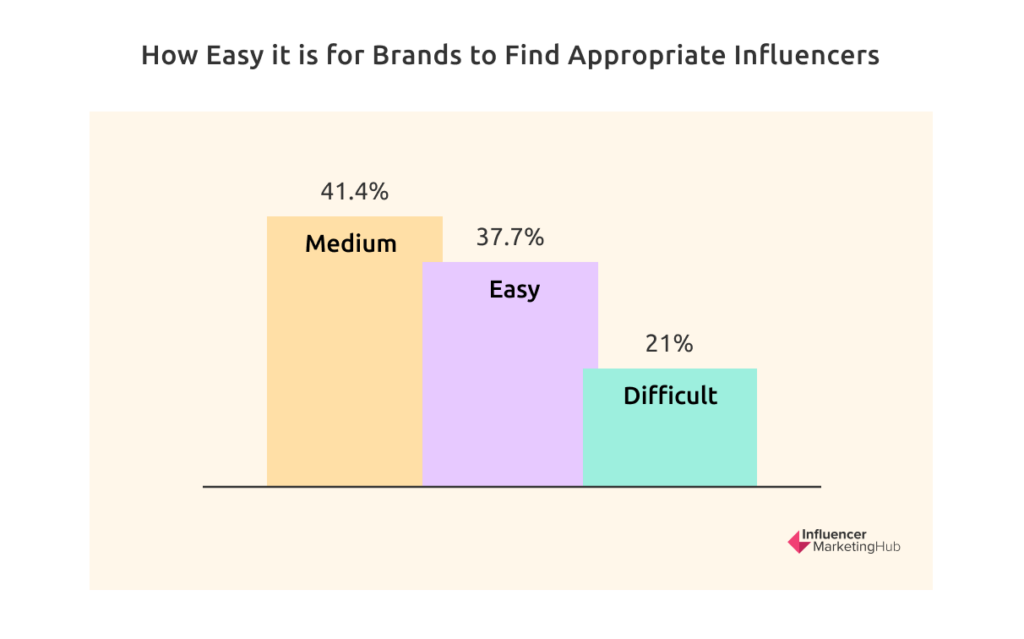
Perhaps the best way to look at this statistic is that 79% don't consider it very difficult to find appropriate influencers. This suggests that brands benefit from having more platforms and other influencer discovery tools available than ever (as well as influencer agencies for those wishing to outsource the entire process). Firms frequently reuse influencers with whom they have worked in the past. Some brands still struggle to find suitable influencers, however, perhaps because they are unwilling to pay for the relevant tools or platforms.
This statistic suggests that influencer platforms and agencies can still do a better job at marketing their services of discovering and reaching out to potential influencers.
The Majority of Firms Have Little Concerns About Brand Safety in Influencer Campaigns
A headline-making issue in past years was influencers acting in a way deemed inappropriate by the brands they represent. For example, Logan Paul once faced criticism over a tasteless video he shared, and brands wondered whether they should continue their connection with him. YouTube has also implemented stricter rules for channels targeting children after concerns about the suitability of some content.
The key to successful influencer marketing is matching your brand with influencers whose fans are similar to your preferred customers and whose values match your own.
An unchanged 36% of our respondents believe that brand safety is always a concern, although 33.7% acknowledge that brand safety could occasionally be a concern when running an influencer marketing campaign.
The remaining 30.3% believe it is not really a concern. Presumably, this last group has mastered the art of finding appropriate influencers for their brands, and they have little concern about incongruent values.
Nearly 75% Believe Influencer Marketing Can be Automated
A contentious issue in influencer marketing in the past was the amount of automation you can successfully use. Some people believe you can automate virtually everything from influencer selection to influencer payment. Others value the personal touch and think influencer marketing is a hands-on process.
This year there has been a small decrease in the respondents believing that automation plays a vital role in influencer marketing (73.4%, down from 77% last year). Most businesses using influencer marketing are happy to use tools and platforms (or work with agencies that do so) nowadays. Initial suspicions about AI and automation have dramatically lessened over the last few years. This small reduction may be antipathy towards the widespread use of AI nowadays.
Content Production is Now Considered Most Valuable When Partnering with Influencers, But Audience Relationship is Still Valued
The most important factor when partnering with influencers for survey respondents is content production at 37.1% (similar to last year's 36%). This ties in with the view that user-generated content is the primary objective when running an influencer campaign.
22.9% of the survey respondents believed audience relationships to be the most valuable factor when considering collaborating with a particular influencer. This is noticeably down on last year’s 29%, and considerably down on 2022’s 51%. Those favoring this option see little value in working with somebody who doesn't really influence their audience or perhaps has an excellent relationship – but has the wrong audience for that brand.
The third popular reason favored by 18.1% of our respondents (up from 17%) found for working with influencers is distribution. Although this is lower than the other options, it connects with audience relationships – influencers use their audience to distribute content relating to a brand.
7.5% of our respondents opted for attribution and tracking (7.4% in 2023). This ties in with those who worked with influencers to generate sales for their partner businesses.
More Than 60% of Respondents Prefer Their Influencer Marketing to be Campaign-Based
We have seen more brands cultivating long-term relationships with influencers in recent times. Yet, most brands still think in terms of influencer marketing campaigns. Once they complete one campaign, they plan, organize, and schedule another one. Brands find that influencers they have worked for on previous campaigns are more genuine. Despite this, a significant 62.9% of influencer marketing relationships are campaign-based (up slightly from 60% in 2023), with only 37.1% "always on" (40% last year).
This preference towards a campaign-based approach could represent brands entering the industry, dipping their toes in the water before making long-term commitments to influencers. Alternatively, they may run multiple campaigns, customizing their selection of influencers for each campaign, depending on the target market. Time will tell whether the nature of brand-influencer relationships changes in any significant way.
The Vast Majority Consider Influencer Marketing to be a Scalable Tactic in their Marketing Ecosystem
One of the most significant advantages of influencer marketing over social activity using official company accounts is the ease of scaling the activity. If you want to create a more extensive campaign, all you need to do is work with more influencers, particularly those with larger followings – as long as they remain relevant to your niche.
While organic influencer marketing may be challenging to scale because of the time needed for influencer identification and wooing, there are approximately 18,900 influencer marketing-related services/companies worldwide that businesses can use to help scale their efforts. Many of these operate globally and accept clients from anywhere in the world.
56.9% of our respondents believe that influencer marketing is definitely a scalable tactic in their marketing ecosystem, and a further 27.2% think it is somewhat of a scalable tactic. Only 15.9% disagree totally with the sentiment. The vast majority recognize that influencer marketing is, to some extent, a scalable tactic in their marketing ecosystem.
Views/Reach/Impressions Are Now the Most Important Criteria When Evaluating Influencers
We have regularly seen that businesses have a variety of objectives when they create influencer marketing campaigns. While the criteria by which our survey respondents evaluate influencers do not precisely match their differing goals, there is some clear correlation.
We noticed last year that brands had changed their most common reasons for working with influencers, and this also flowed through to how they evaluate the success of influencers in meeting goals. This pattern continued this year, although to a slightly lesser extent.
32.9% of our respondents consider views/reach/impressions to be the most important criterion (35% last year), while 21.1% opted for content type/category (compared to 19% last year).
A consistent 18.4% preferred to focus on Sales (18% in 2023). Almost as popular with 16.4% support was engagement or clicks (17% in 2023). This was a major decrease from 2022, when 39% opted for this category, ahead of everything else.
The remaining 11% of the respondents have different ideas on this topic, opting for Other as the most important criterion when evaluating influencers.
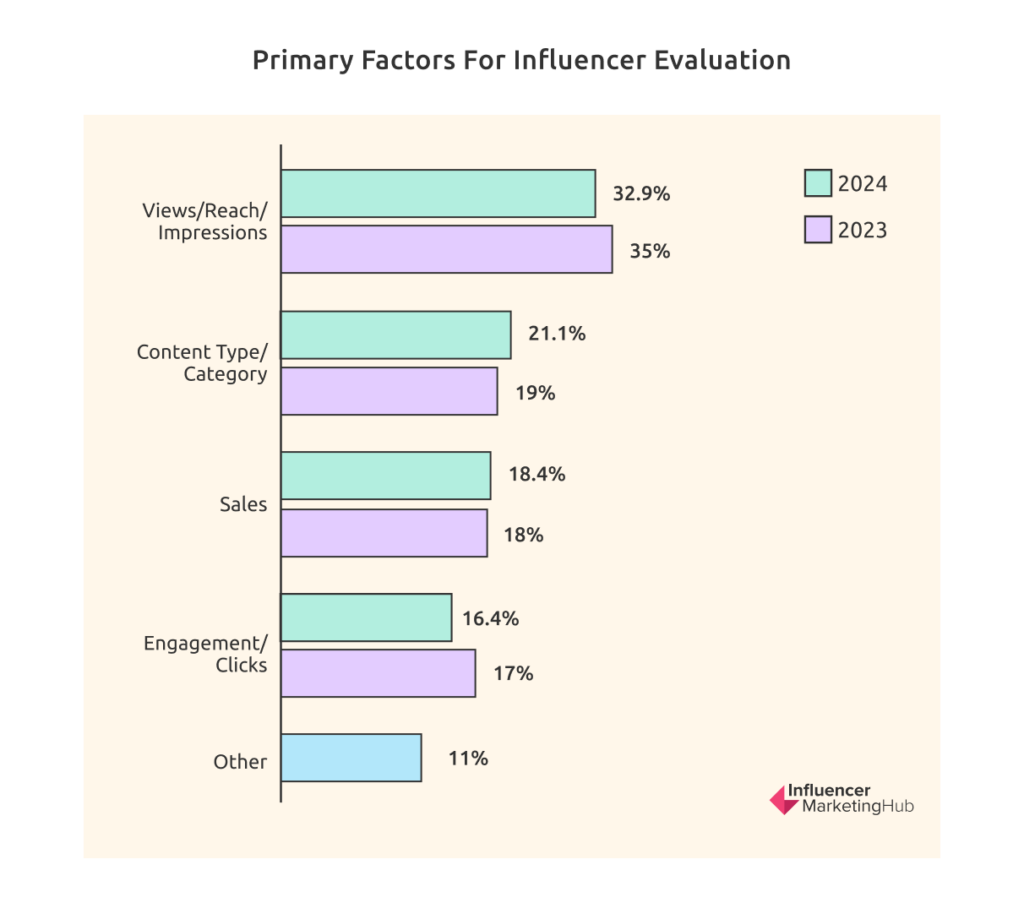
60%+ of Brands Work with More Than 10 Influencers
We asked those respondents engaged in influencer marketing how many influencers they had worked with over the last year. This year we noticed the continuation of a gradual movement towards working with greater influencer numbers. 37.6% of our respondents stated that they had worked with 0-10 influencers (39% last year). A further 19% had worked with 10-50 influencers (21%) and 15.2% had worked with 50-100 influencers (16%).
Some brands prefer to engage in influencer marketing on an even larger scale, with 13.5% of those surveyed collaborating with 100-1000 influencers (11%). For the second year running, we saw an increase in the number of those working with influencers on a massive scale, with 14.7% working with more than 1,000 influencers, compared to 12% last year (and just 3% in 2022).
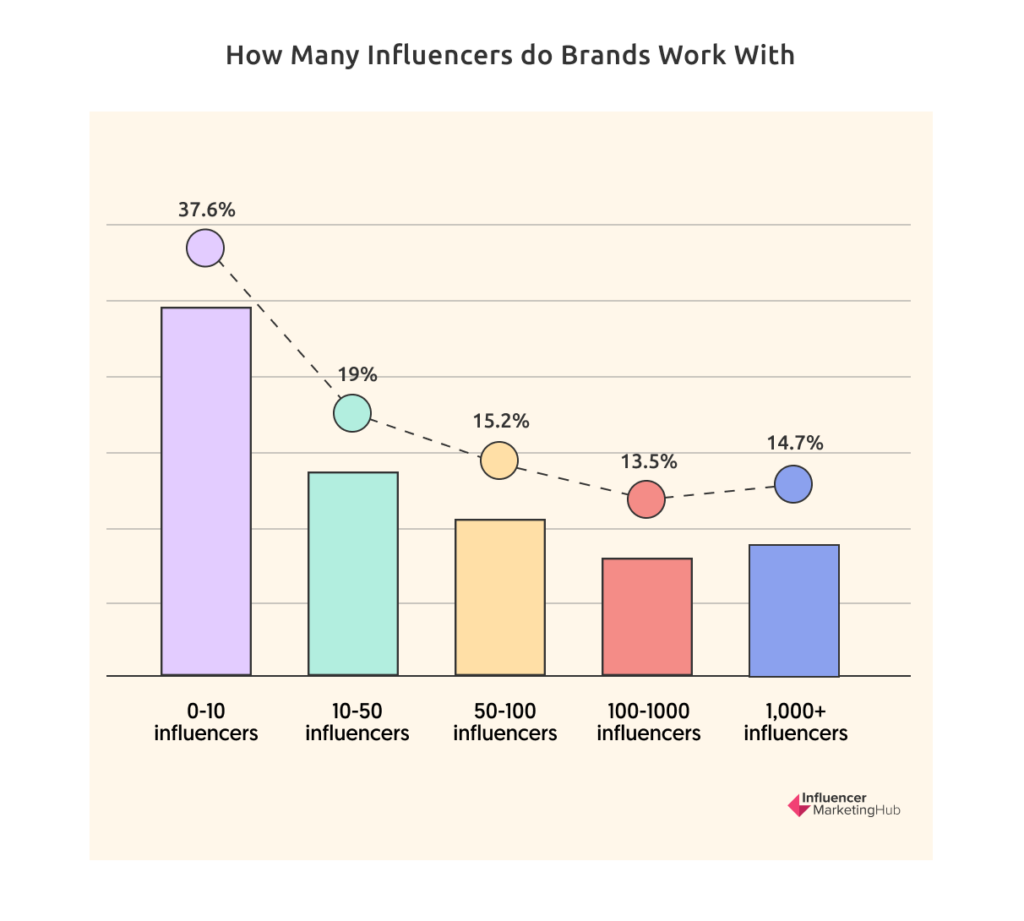
These figures probably indicate just how many brands now collaborate with multiple nano- and micro-influencers, rather than just a few macro-influencers and celebrities.
Nearly Half of All Influencer Campaigns Are Run Monthly
We saw a gradual movement in favor of quarterly campaigns over many years, to the point where it was the most popular campaign type in 2022, but in 2023 the longer campaign period fell dramatically out of fashion.
Of those who operate discrete influencer campaigns, 49% (48% in 2023 and 34% in 2022) now prefer to run them monthly. A further 15% (18% in 2023 and 35% in 2022) run quarterly campaigns. Just 14.4% (15% in 2023 and 14% in 2022) prefer to organize campaigns annually. These later companies are probably brands that like the "always-on" approach to influencer marketing. The remaining 21.5% (19% in 2023 and 18% in 2022) take a different approach and only run campaigns whenever they launch a new product.
Finding Influencers to Participate is Again the Greatest Challenge for Those Who Run Campaigns In-house
We asked those survey respondents who ran campaigns in-house what they saw as the greatest challenges they faced. Apart from a blip in 2022, the most significant challenge has consistently been finding influencers to participate in their campaigns, and it remains the main problem faced this year Despite the increase in usage of both internally developed and external tools to ease the discovery process, 29.8% of respondents ranked this as their top concern, although that is down from 36.3% last year.
Another area of high concern to our respondents is processing payments to influencers on 17.1% (up slightly from 15.3% last year). This is followed by managing the contracts/deadlines of the campaign 13.9% (13.2% in 2023)
We saw a continued drop in 2022’s top concern, measuring ROI and campaign results, with 13.6% opting for it (14.9% in 2023, 28.1% in 2022).
There must be a variety of new concerns now, however, as the second-highest category this year was Other with 21.2% support (14.2% in 2023).
Our partner, HypeAuditor, provides much of the data for the next section.
Social Media User Demographics Statistics
This section highlights statistics that emphasize the types of people most likely to use social media. When you are searching for influencers to promote your brands, you will want to focus on those influencers who are followed by the type of people most likely to be interested in your products or services. The social media network where each influencer has gained the most fame impacts this – clearly, you want to work with popular people on the same social networks where your potential customers spend their time. Remember, just because you spend time on a particular social network doesn't mean that your customers do too, particularly if they are of a different demographic than yourself.
The Majority of Instagram Users Are Aged 25-34
As with last year, the majority of Instagram users are people aged 25-34 (46.81%), followed by 18–24-year-olds (33.17%). In both cases, more females than males use Instagram, although the difference is less for 25–34-year-olds: 18-24 yr-olds (56% female: 44% male), 25-34 yr-olds (52% female:48% male).
For the second year, however, we notice that there are more male Instagram users than females in (almost) all older age groups. For example, the ratio of Instagram users aged 45-54 is 32% female:68% male, although this is based on low overall numbers. Does this indicate that older males are more likely to have an interest in graphics, design, and photography than their female counterparts?
We saw elsewhere in this report that Instagram has lost its spot as the “Top Dog” influencer marketing platform to TikTok. This is possibly a reflection of a lack of interest from Generation Alpha and a reduction in Generation Z – only 4.27% of 13–17-year-old females and 3.11% of 13–17-year-old males now use Instagram. This must have Meta wondering.
TikTok is the Favorite of 13–24-Year-Olds.
Anyone who thought TikTok was just a flash in the pan, ready to fade away as the next trend arrived, doesn’t understand the power of TikTok to hook its audience. If you want to reach 13-24-year-old females it is where you should focus your marketing. 24.27% of TikTok’s audience are 18–24-year-old females and 17.04% are 13–17-year-old females. Surprisingly, males take to TikTok later, with more 25–34-year-olds liking it (15.74% compared to 11.77% for females of that age), as they do with Instagram.
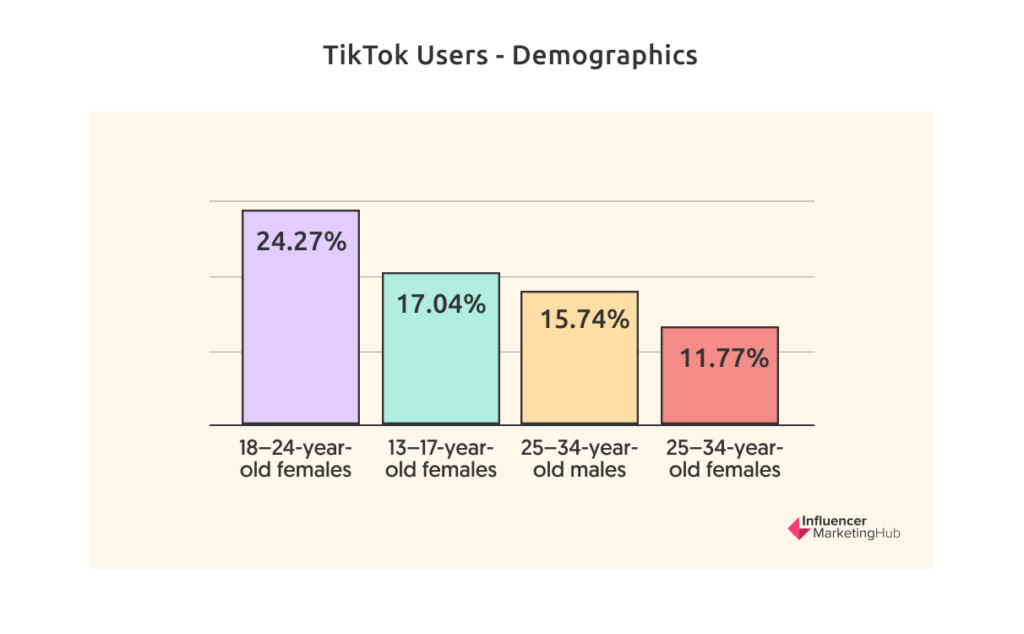
Also, like Instagram, there are more older TikTok male users (albeit still a very small percentage overall) than female users.
57% of YouTube Viewers Are Male, But Females Dominate the Younger Age Groups
As with Instagram and TikTok, more young females watch YouTube videos than males: Females 13-24 (26%) vs Males 13-24 (22%). However, in all other age groups, males are more likely to view YouTube videos.
Maybe this is because of the inherently passive nature of YouTube compared to TikTok – you can easily view YouTube videos like a traditional television – but you almost feel compelled to engage when watching TikTok videos.
We commented last year, how almost 1 in 5 YouTube views came from male Millennials (25–34-year-olds). This year, that group loves YouTube even more, and now watches 22.2% of all YouTube views.
Lifestyle and Music Top Instagram Influencer Niches
The most common niche in which Instagram influencers posted in 2020, 2021, and 2022 was Lifestyle. This is no great surprise when you consider which influencers are the best known to most people. In addition, lifestyle is an easy niche to share captivating, vivid images.
However, we have seen an interesting change in second place. The inherently non-visual category of Music now takes second place, with Beauty dropping to third. Is this a sign of Instagram’s male users having an impact?
Third-placed Beauty is highly visual, however, making it an ideal subject for posting on Instagram. Also, when you consider Instagram's core audience is still 25-34 females, it is hardly surprising that beauty influencers would remain relatively popular on the platform.
Influencer Engagement
Instagram Influencer Engagement Fell to Lowest Level in Five Years
In all the time we have reported on influencer marketing, we have observed a general pattern of Instagram accounts with large numbers of followers having a lower engagement rate than accounts with fewer followers. This is logical – it is much harder for popular influencers to reply to every comment and engage as closely with each follower as smaller Instagrammers. This is because people only have limited time to engage. Also, many people deliberately choose to follow popular influencers passively, happily "lurking," and viewing shared images without active participation.
We have seen a general reduction in engagement over the last few years, however, particularly for large accounts. Indeed, engagement for accounts with over a million followers (0.95%) is now less than half what it was in 2018 (1.97%).
Average engagement overall now stands at 2.05%, down from 2.18% in 2021. However, it is close to 2019’s pre-Covid rate of 2.08%.
TikTok Engagement is Considerably Higher Compared to Other Social Networks, Even for Large Influencers
We have observed elsewhere in this Benchmark Report how TikTok has now become the platform of choice for influencer marketing. Not bad for a social channel that we lumped under “Other” until a couple of years ago. One reason for this is undoubtedly the platform’s phenomenally high comparative engagement rates.
We’ve just written about how Instagram’s engagement rates range from 0.95% for accounts with over 100K followers to 4.21% for accounts with fewer than 5K followers. In comparison, TikTok’s largest accounts with over 1M followers average 10.53% engagement, and small accounts with 1K-5K followers have an incredible 15.04% engagement. No wonder more brands are wanting involvement there.
In one way, however, TikTok has become more “normal”. Last year, we reported the oddity that large TikTok accounts had better engagement than smaller accounts. This year, as we showed above, engagement levels picked up for the smaller accounts, meaning that TikTok now exhibits the normal distribution pattern again.
Larger YouTube Channels Have Better Engagement Than Smaller Channels
While TikTok may have returned to its usual engagement distribution pattern, YouTube hasn’t (quite) yet. Larger YouTube channels have higher engagement rates than smaller channels. Technically, channels with 100K-1M followers have the highest engagement rate (3.47%), but huge YouTube influencers (1M+ followers) aren't far behind (3.40%). In comparison, small YouTube channels with just 1K-5K followers only manage an engagement of 1.90%.
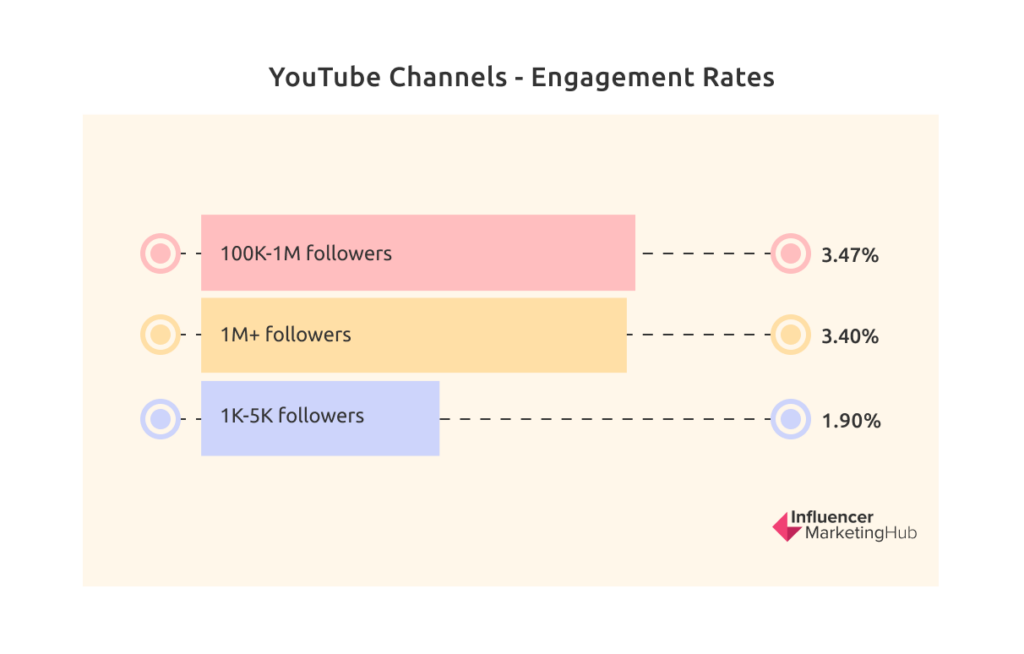
Instagram Influencer Fraud Has Continued to Decline Since 2019
In those heady pre-Covid days, influencer fraud became a significant discussion point. Indeed, there was a danger that influencer fraud could stop the still-nascent industry in its tracks.
Since then, there have been many tools and platforms developed that brands can use to detect influencer fraud. As a result, the percentage of influencer accounts impacted by fraud fell across the board. By 2021 it was just less than 50%. Rates fell further in 2022, reaching 36.68% on average. Unsurprisingly influencer fraud has had a much greater impact on larger Instagram accounts than on small ones, where fraudsters have less to gain.
As the data indicates, it is still a problem for some influencers, however. Also, as we saw in our Benchmark survey, more brands are now admitting to having been affected by fraud than ever before. It is advisable, therefore, that all brands use the available tools to ensure influencer authenticity when searching for suitable influencers.
Despite us lumping everything together as 'influencer fraud", in some cases, the influencers are the victims, not the perpetrators. For this report, we consider "influencers impacted by fraud" to be Instagram accounts with over 1000 followers with growth anomalies or inauthentic engagement (comments and likes from bots, giveaway comments, comments from Pods, etc.) Not all influencers impacted by fraud do so on purpose. On average, 36.8% of influencers globally are affected by fraud. This is down somewhat from last year’s 49.23%.
The Most-Mentioned Brands on Social Media in 2022
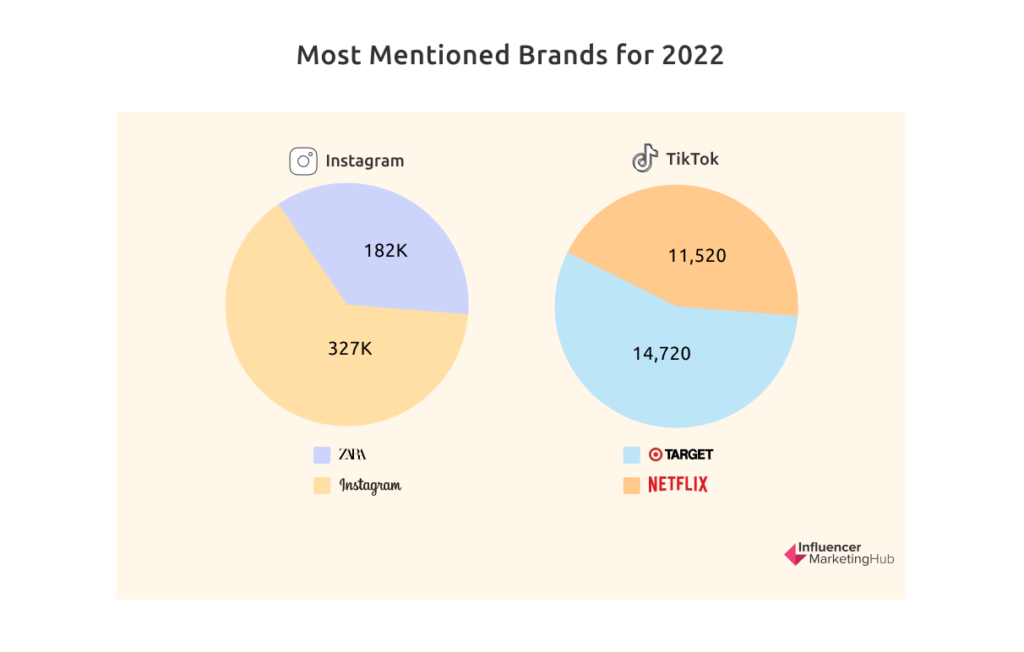
Zara Was the Most Mentioned Brand on Instagram in 2022 … Apart from Instagram Itself
Although Zara’s Instagram numbers were smaller than last year, they will be loving the 182K Instagram mentions they received in 2022. Of course, it helped that it had nearly 66K influencers posting and sharing about their products, with a combined reach of more than 1.2 billion people.
However, after a quiet 2021, Instagram once again took the engagement lead on its platform in 2022, with 327K mentions, 86K influencers, and an estimated reach of 1.8 billion.

We commented last year on how pleased YouTube must be to have the tenth most mentions on social rival Instagram. Well, this year YouTube improve on this, coming in eighth place.
Target Was the Most Mentioned Brand on TikTok in 2022
In 2021, TikTok saw an interesting cross-brand trend, with the streamer, Netflix, being the most mentioned brand on the platform. When people weren't watching videos on Netflix, they were talking and making videos about what they'd streamed on TikTok.
Alas, Netflix couldn’t quite repeat the feat in 2022, however, although they almost did, being the second-most mentioned brand.
Top place in 2022 went to retail goliath, Target, which received 14,720 mentions compared to Netflix’s 11,520.
Notably, however, Netflix’s 31M followers swamped Target’s 2.1 million.
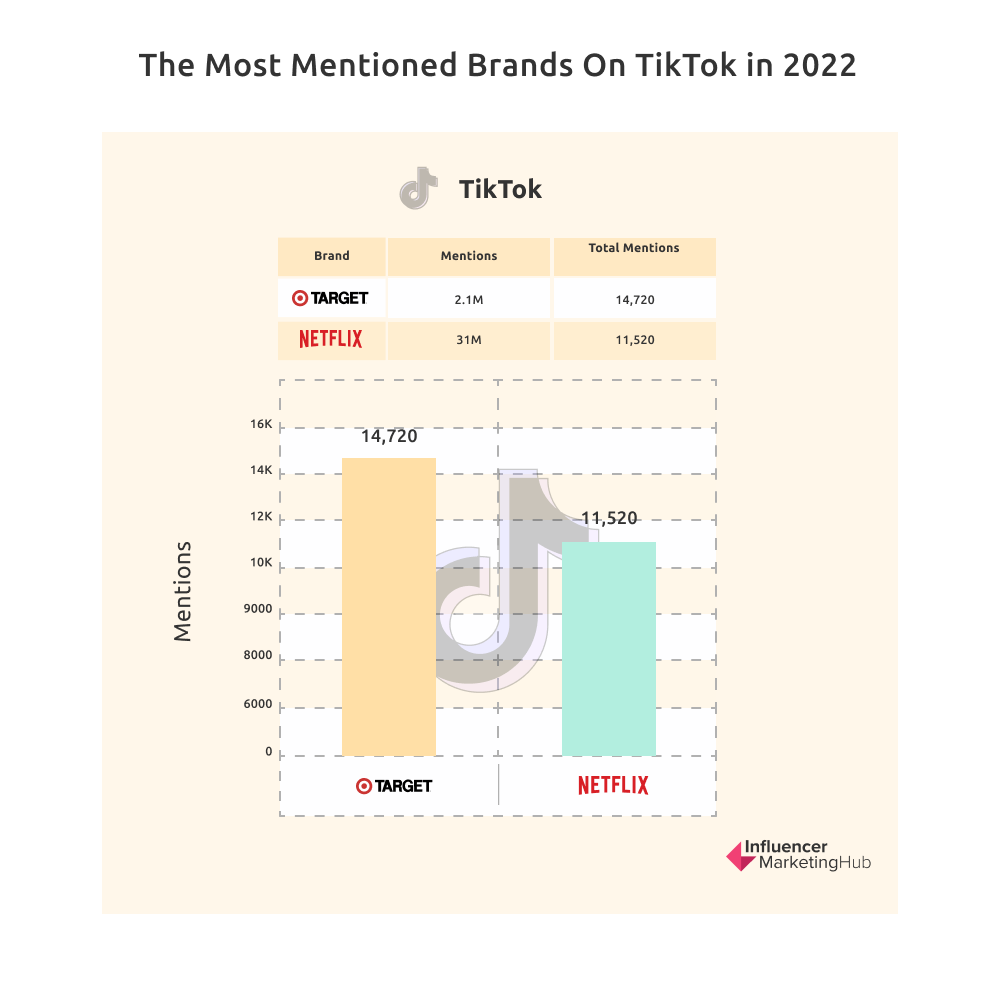
Highlights from our Diversity, Equity & Inclusion (DEI) in Influencer Marketing: Racial and Gender Inequalities Report.
Diversity, Equity, and Inclusion (DEI) in Influencer Marketing:
Nearly 60% of Influencers Felt They Faced Discrimination
We asked our influencers whether they feel they have ever been discriminated against (as an influencer) on any social platform. 58.3% stated they had, leaving 41.7% who hadn't.

Almost 50% of Influencers Face Discrimination Based on Their Gender
When asked to highlight an area of discrimination the respondents felt they had faced, 47.73% believed they had suffered from gender discrimination. Physical feature discrimination (21.75%) followed this, then racial discrimination (13.29%), political discrimination (9.06%), and sexual discrimination (8.16%).
TikTok Provided the Worst Discrimination Faced by Influencers
We asked influencers to name a channel where they encountered discrimination. Significantly more than half of those respondents who had faced discrimination received it on TikTok (58.42%), compared to YouTube (13.62%), Instagram (12.9%), and Facebook (10.04%).
We have seen elsewhere in this report that TikTok has been increasingly important for brands wishing to engage in influencer marketing. Yet is it not always an easy platform to establish yourself as an influencer, particularly if you are outside the “norm”.
Macro- and Mega-Influencers Suffer Most from Discrimination
Macro-influencers (81.25%) and Mega-Influencers (69.7%) are most likely to report facing discrimination than smaller, less popular influencers. This is possibly a reflection of their fame – they are more visible than most, making them greater targets for “haters.”
Wrapping Things Up
In earlier versions of this benchmark report, we always used to observe that influencer marketing was still a relatively new industry, enjoying its time as the “next big thing”. Even we, the strong influencer marketing champions that we are, wondered just how long it would last until some new “shiny new object” came along. Yet, as we can see from this, our eighth annual State of Influencer Marketing Benchmark Report, the industry is as strong as ever, and the participants are still as optimistic about the success of their campaigns.

